Updated: December 3, 2025
By Santorini Dave • dave@santorinidave.com
Quick Tips
• If you are flying into Heathrow, staying in Paddington (for the Heathrow Express) or anywhere near a Piccadilly Line station is incredibly convenient. If arriving at Gatwick, a hotel near Victoria Station (for the Gatwick Express) will make your transfer seamless.
• Before you book a hotel, check its address on Google Maps and confirm it is no more than a 5 to 7 minute walk to the nearest Tube station. Even better is a hotel near a station served by multiple Tube lines (like Victoria, King’s Cross, South Kensington, or Waterloo), which drastically reduces your travel time across the city.
• For first-time visitors to London the Covent Garden neighborhood is ideal.
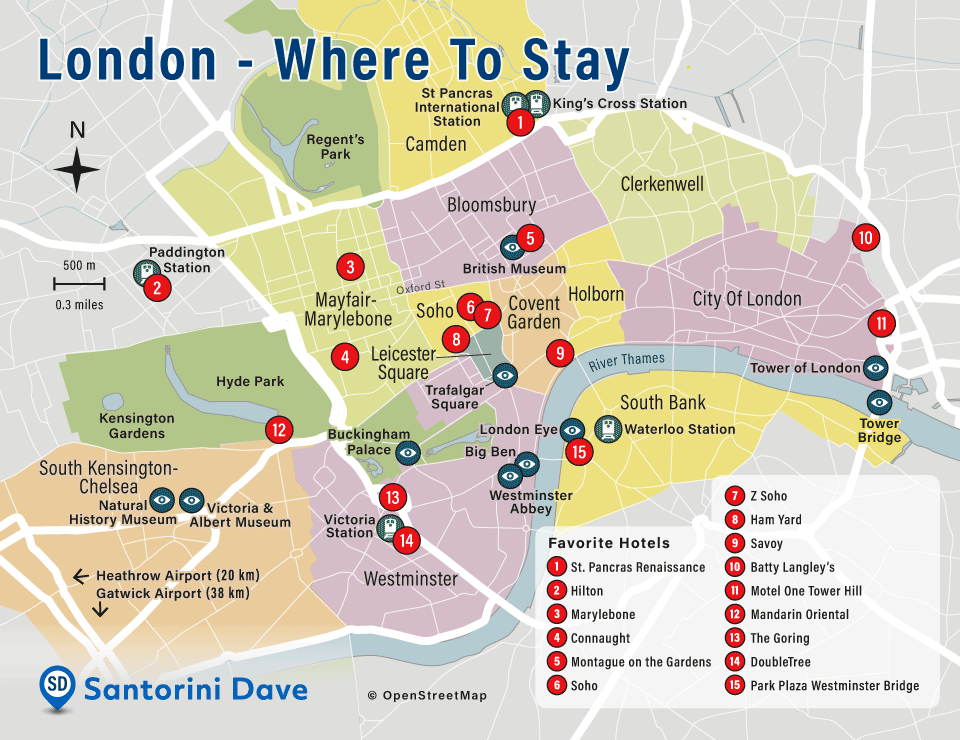
1. St. Pancras Renaissance • 2. Hilton • 3. Marylebone • 4. Connaught • 5. Montague on the Gardens • 6. Soho • 7. Z Soho • 8. Ham Yard • 9. Savoy • 10. Batty Langley’s • 11. Motel One • 12. Mandarin Oriental • 13. The Goring • 14. DoubleTree • 15. Park Plaza
Best Area to Stay in London
My Favorite Hotels in London
- 5-Star: The Connaught • The Savoy
- 4-Star: Ham Yard Hotel
- Boutique: Batty Langley’s
- Budget: Motel One • Z Soho
- For Families: Park Plaza Westminster
- For Couples: The Soho
- King’s Cross: St. Pancras Renaissance
- Victoria Station: DoubleTree Victoria
- Paddington: Hilton
- Airports: Sofitel Heathrow • Sofitel Gatwick
My wife and I at The Savoy in London.
The most important thing to understand about London is that there is no single city center or “downtown.” The city is a vast collection of distinct neighborhoods, each with its own character and history, acting almost like a series of connected villages. London’s best attractions, museums, theaters, and restaurants are scattered widely across these different areas.
Because everything is spread out, you will rely heavily on public transport. This brings me to my number one rule for choosing a hotel in London: The best neighborhood to stay in is any neighborhood with a hotel near a Tube station.
Proximity to the Underground is the single most important factor for a convenient trip. Being a 2-minute walk from a Tube station in a “lesser” neighborhood is far better than being a 15-minute walk from one in a “prime” neighborhood.
With that rule in mind, you can narrow your search based on your specific interests. The best London hotels are located all over the city, so you can find great luxury, boutique, or family-friendly options almost anywhere.
Quick Neighborhood Guide
- For Theater & Nightlife: Look at Covent Garden and Soho.
- For Major Museums & Parks: Look at South Kensington.
- For Royal Palaces & History: Look at St. James’s and Westminster.
- For Trendy Dining & Markets: Look at Shoreditch and the East End.
No matter where you choose, as long as you can easily hop on the Tube, all of London will be within your reach.
Charming Covent Garden in the West End is one of the best areas for first-time visitors to London.
Good hotels in Covent Garden:
Covent Garden Hotel • ME London • NoMad London • One Aldwych • Resident Covent Garden • The Savoy • The Fielding • The Z
An Introduction to London’s Neighborhoods
Most of London’s major sights and best places to stay are located north of the River Thames, which winds its way through the city. The key to choosing the right neighborhood is understanding what each area offers, from the non-stop energy of the West End to the stately grandeur of Westminster.
The West End (Covent Garden, Leicester Square, Soho, Mayfair)
This is the true heart of tourist London and the best place to stay for most first-time visitors. It is the city’s entertainment and dining hub, packed with theaters, world-class art galleries, and restaurants for every budget. The area is very walkable and has excellent transport links.
• What’s Here: West End theatres, Trafalgar Square, The National Gallery, Covent Garden Market, and the main shopping arteries of Oxford Street and Regent Street.
• Hotels: Dominated by 4-star and 5-star hotels, but some excellent mid-range and value options are tucked away.Westminster & St. James’s
Just southwest of the West End, this is the center of Royal and Political London. While it has fewer hotels and restaurants, you will spend a lot of time here visiting some of the city’s most iconic landmarks.
• What’s Here: Buckingham Palace, the Houses of Parliament (Big Ben), Westminster Abbey, and the tranquil St. James’s Park.
• Hotels: Dominated by grand, old-world luxury hotels catering to diplomats and discerning travelers. There are very few mid-range options and almost no budget hotels. Staying close to Buckingham Palace puts you within easy walking distance of many of London’s top attractions.Bloomsbury & Fitzrovia
Located just north of the West End, this area offers a calmer, more intellectual atmosphere with leafy squares and a literary history. It’s still incredibly central but feels more relaxed.
• What’s Here: Home to the magnificent British Museum (one of the world’s best) and numerous peaceful garden squares like Russell Square and Bedford Square.
• Hotels: A nice mix of accommodation, generally offering better value than the neighboring West End.The South Bank & Southwark
Stretching along the southern bank of the Thames, this regenerated area is London’s cultural riverside promenade. It’s a beautiful walk with non-stop attractions and incredible views of the city skyline.
• What’s Here: The London Eye, Tate Modern, Shakespeare’s Globe Theatre, Borough Market, and The Shard (Western Europe’s tallest building).
• Hotels: A mix of modern, stylish hotels, many with fantastic river and skyline views. You’ll find everything from high-design luxury properties to trendy, good-value hotels like CitizenM and The Hoxton.South Kensington & Knightsbridge
West of Westminster lies this upscale and elegant residential district. It’s known for its world-class museums and high-end shopping.
• What’s Here: A cluster of London’s best museums (the V&A, Natural History Museum, and Science Museum) and luxury shopping at Harrods.
• Hotels: A hub for some of London’s most famous and opulent 5-star hotels.The City of London
To the east of the West End is the city’s original historic core and its modern financial center. It’s packed with history and is busy on weekdays but can be very quiet on weekends.
• What’s Here: The Tower of London, Tower Bridge, and St. Paul’s Cathedral.
• Hotels: Mostly business-focused hotels that can offer great value deals on weekends.Other Key Neighborhoods
• King’s Cross: North of Bloomsbury, this is a major transport hub. It offers a direct Tube connection (Piccadilly Line) to Heathrow and direct train service to Luton, and is home to the Eurostar terminal at St. Pancras. The area has been regenerated with many trendy new restaurants and hotels.
• East London (Shoreditch & Spitalfields): East of the City, this is London’s trendy, creative hub. Come here for vibrant markets (Spitalfields, Brick Lane), street art, and buzzing nightlife.
• Camden: To the north, Camden is famous for its alternative markets, live music venues, and punk-rock history.
• Greenwich: Downriver to the southeast, Greenwich makes for a great day trip. It’s known for its maritime history, the Royal Observatory (home of the Prime Meridian Line), and a beautiful royal park.
Top tip:
Stay close to a tube station. The tube allows you to get pretty much anywhere in the city quickly and easily. Most hotels in central London are within walking distance of a tube station but the ones listed below are a two-minute walk or less.
Good hotels very very close to a tube station:
• NoMad (Covent Garden): A cool hotel in a former courthouse, just a 90-second walk from Covent Garden Tube.
• The Clermont (The Strand): A grand Victorian railway hotel with modern style, offering direct access to Charing Cross station.
• Kimpton Fitzroy (Bloomsbury): A grand landmark hotel with luxe interiors, located directly across from Russell Square Tube station.
• The Cumberland (Marylebone): A modern hotel focused on music and style, located right next to Marble Arch Tube station.
• Rosewood London (Holborn): A sophisticated luxury hotel in a Belle Époque palace, just a two-minute walk from Holborn Tube station.
• Hilton Paddington (Paddington): A classic Art Deco hotel inside the station, offering direct access to the Paddington Tube and Heathrow Express.
• St. Pancras Renaissance (King’s Cross): An iconic gothic hotel inside the station, offering direct access to King’s Cross St. Pancras Tube.
• citizenM Tower of London (City of London): A smart, modern hotel with amazing views, situated directly on top of Tower Hill Tube station.
• Mandarin Oriental Hyde Park (Knightsbridge): An elegant, opulent hotel overlooking Hyde Park, located steps from the Knightsbridge Tube station.
• DoubleTree (Victoria): A reliable and modern hotel for travelers, located directly opposite Victoria Tube station and the Gatwick Express.
• Hilton Hyde Park (Bayswater): An Edwardian townhouse hotel with park views, located directly across from Queensway Tube station.
• Conrad St James (Westminster): A smart and stylish hotel for politics-watchers, situated directly opposite St. James’s Park Tube station.
• The Hoxton (Southbank): A popular and stylish hotel with great social spaces, just a two-minute walk from Southwark Tube station.
• Andaz Liverpool Street (City of London): A stylish modern hotel in a Victorian building, integrated with the Liverpool Street Tube station.
• The Ned (City of London): A grand and bustling hotel in a former bank, located steps from the Bank Tube station interchange.
• Motel One (City of London): A stylish budget design hotel with a cool bar, just a two-minute walk from Aldgate station.
How to Get Around London
Getting around London is fast and efficient using the city’s world-class public transport system. Navigating it is simple if you follow one key piece of advice.
The Best Way to Pay for Transport
Forget about complicated passes or paper tickets. There is only one method you need to know.• Use a Contactless Card or Phone Pay: This is the easiest and cheapest way to travel. For phone pay, there is no special transport card to buy or load; just use any credit or debit card already in your Apple Pay or Google Wallet. Simply tap your card or phone on the yellow card readers at the start and end of your journey (no tap out on buses), and the system automatically calculates the cheapest fare for you. Fares are “capped,” meaning you will never pay more than a set amount for a single day or a full week (Monday to Sunday), no matter how many journeys you take.
Should You Rent a Car in London?
• No. Absolutely not. Driving in London is a terrible idea for a visitor.
• Public transport is faster, cheaper, and far more efficient.
• Parking is extremely limited and very expensive.
• You must pay a £15 daily Congestion Charge to drive within the central zone.The Best Places to Stay in London
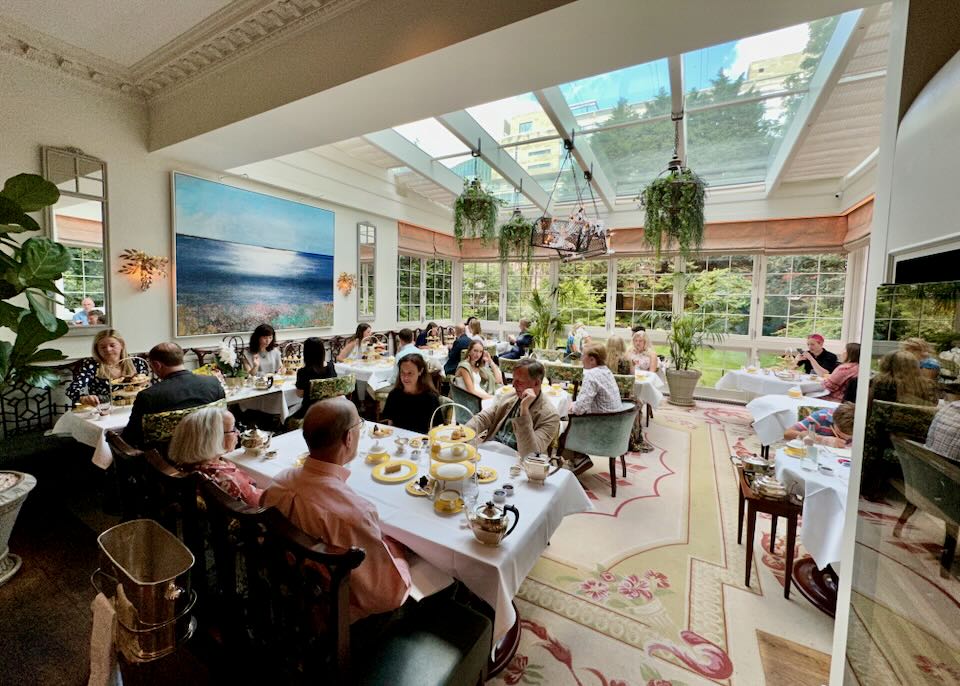
The historic Goring near Buckingham Palace. Everything from the doorman to afternoon tea is classy, refined, and quintessentially British.
- Best Luxury Hotels in London
The Connaught • The Goring • Rosewood London • The Savoy • Shangri-La The Shard • Mandarin Oriental Hyde Park- Best Boutique Hotels in London
The Mandrake • The Soho • Montague on the Gardens • Batty Langley’s • Ham Yard • Vintry and Mercer- Best Midrange Hotels in London
citizenM Tower of London • Motel One • Park Plaza County Hall • Park Plaza Westminster Bridge- Best London Hotels for Families
Taj 51 Buckingham Gate (luxury) • The Athenaeum (luxury) • Park Plaza Westminster Bridge (midrange) • DoubleTree (budget)- Best Cheap Hotels in London
London Visitors Hotel • The Z Soho • The Z Covent Garden- Best Hostels in London
Wombat’s City Hostel • YHA London Central
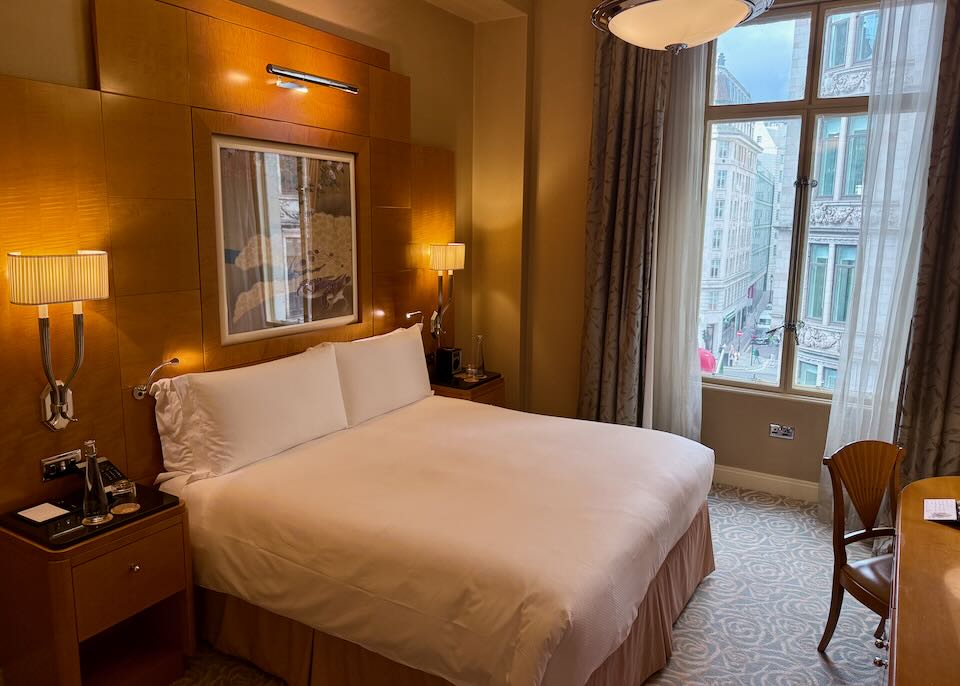
Our room at The Savoy in Covent Garden.
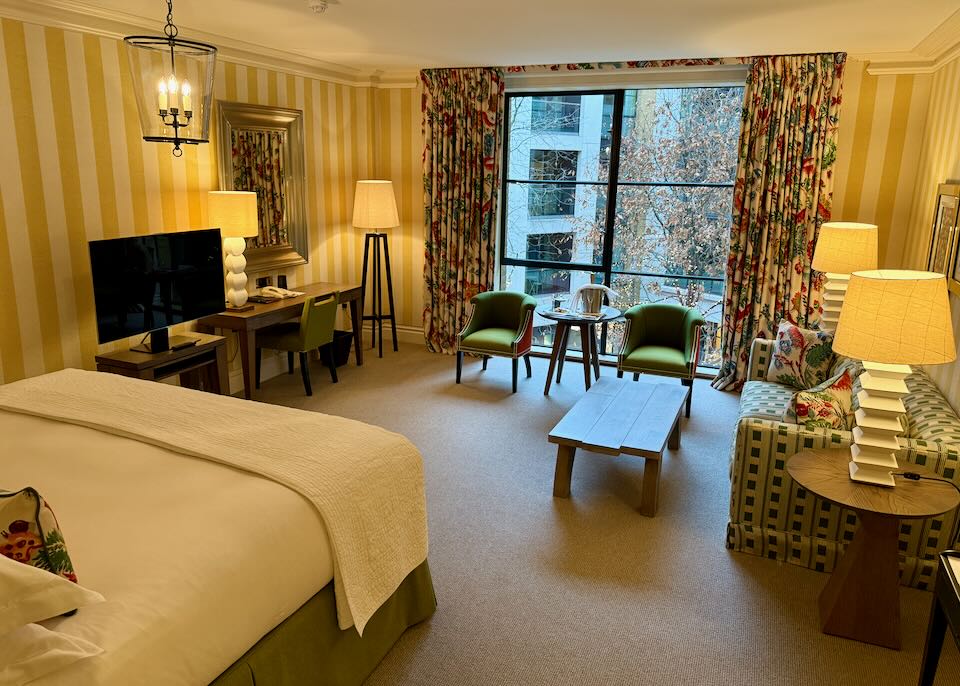
Our room at the Ham Yard in Soho.
More Notable London Hotels
I bought, read, and highlighted-extensively the most recent London guidebooks from Lonely Planet, Frommer’s, and Rick Steves. Here are some of their most interesting hotel picks. (I highly recommend buying one of these books for when you’re in London.)Lonely Planet:
• Hazlitt’s ($$$, West End) – This Soho gem was built in 1718 and comprises four original Georgian houses.
• Lime Tree Hotel ($$, Westminster) – Beautiful 28-room Georgian town house hotel is all comfort, British design, and understated elegance.
• citizenM Tower of London ($, The City) – Compact and well-designed. Some rooms have extraordinary views of the Tower of London.Frommer’s:
• Dukes London ($$$, St James) – Cozy, clubby luxury but more affordable than it ought to be.
• Zetter Townhouse ($$, Marylebone) – Eccentric luxury hotel near Hyde Park and Oxford Street.
• Jesmond Hotel ($, Bloomsbury) – The Jesmond is a classic and has been a Frommer’s pick since rooms cost $3.20.Rick Steves
• Number Sixteen ($$$, Kensington) – Packs over-the-top class into 41 artfully imagined rooms. Perfect for an urban honeymoon.
• Vancouver Studios ($$, Notting Hill) – 48 modern, tastefully furnished rooms come with fully equipped kitchens.
• Seven Dials ($, Covent Garden) – 38 plain, clean, and incredibly well located rooms.Best Places in London for…
- Best Neighborhoods in London for Sightseeing: Covent Garden, Soho, South Bank
The South Bank is excellent for access to big attractions – London Eye, Tate Modern, the Shard – and it’s an easy stroll across several Thames footbridges to the City of London and the West End neighborhoods. Covent Garden and Soho are good all-rounders due to their proximity to the river, Westminster, and other top sights; ample accommodations are a boon. South Kensington is great for museums and shopping, but hotels tend to be pricey and it’s not quite as central.Having a pint at a Soho pub.
- Best Neighborhoods in London for Nightlife: Soho and Shoreditch/Hoxton
The best area in London for nightlife is Soho. The neighborhood is a good mix of trendy cocktail bars (many of which also do great food), traditional English pubs, theaters, and basement clubs with DJ nights, including a number of LGBTQA+ venues. Ronnie Scott’s is a legendary jazz club, while the French House is a popular bar, and Bar Italia is an old-school late-night café. Bar Termini is fabulous for cocktails. There are only a few hotels in Soho, slightly set back from the action. Other good areas for nightlife include Camden with its live music venues and Shoreditch/Hoxton in the East End, with its legendary clubs. Highlights include the Queen of Hoxton, with its rooftop, DJs, and ping pong tables, the Boundary Rooftop in Shoreditch, and Happiness Forgets for cocktails.- Best Neighborhoods in London for Food and Restaurants: Soho, Clerkenwell, Shoreditch
Soho is jam-packed with artisan coffee shops and global offerings. Highlights include the udon noodles at Koya, Thai food at Kiln, superb French restaurant Brasserie Zédel, and modern British champion Quo Vadis. There’s also old-school Bar Italia for espresso and Gelupo for ice cream. And Chinatown is still a great place to sample Chinese food and drinks, from dim sum to bubble tea and Beijing duck (the Food House is the current trendsetter).For something a bit more cutting-edge, look to Clerkenwell and Shoreditch on the fringes of The City: in the former, Prufrock Coffee is London’s most famous coffee shop, the Fryer’s Delight is for fish and chips, and Sushi Tetsu is uber-exclusive, while restaurants like St John and the Quality Chop House create lauded modern British cuisine. Shoreditch boasts the pasta at Burro e Salvia, London’s best barbecue at Smokestak, banh mi at Kêu Deli, and Michelin-starred Brat, Clove Club, Leroy and Lyle’s. Camden, the East End, and King’s Cross are great for street food, as is Borough Market and Bermondsey on the South Bank – 40 Maltby Street is one of the city’s best restaurants.
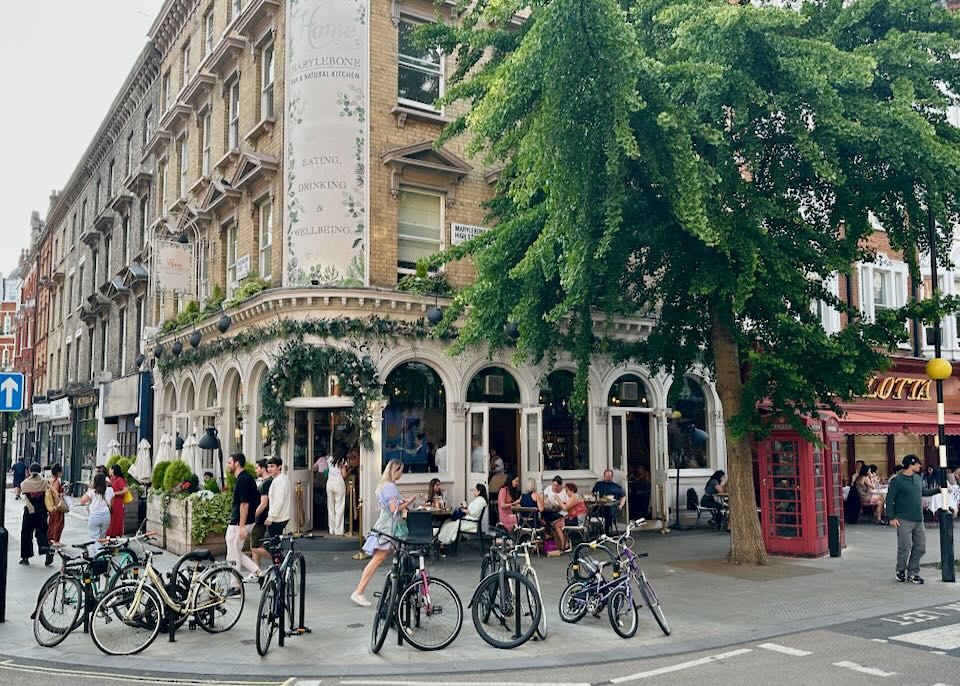
The charming village-like feel of Marylebone makes it perfect for families.
- Best Neighborhoods in London for Families: South Bank, South Kensington, and Marylebone
For families who want to be in the heart of the action, this is the place to be. It’s a vibrant, pedestrian-friendly stretch along the River Thames and an easy walk to major attractions like the London Eye, SEA LIFE Aquarium, and Borough Market. South Kensington is another fantastic option, where you are on the doorstep of three of the world’s best free museums: the Natural History Museum, the Science Museum, and the V&A. The area is beautiful and quiet (for central London), with the huge Hyde Park just north for playgrounds and open space. Marylebone is also a great choice, offering a wonderful, high-end village feel while still being completely central. It is perfectly located between Regent’s Park, home to the London Zoo, and Hyde Park, and is a short walk from attractions like Madame Tussauds.My son and I on the Classic Afternoon Tea Bus Tour in London. We loved it.
- Best Neighborhood in London to Stay for First Timers: Covent Garden
Covent Garden is the best neighborhood for first-time visitors. It’s centrally located, has a great dining and theater scene and is within easy walking distance of numerous big attractions, such as the National Gallery, Houses of Parliament, and the London Eye. There are excellent public transport connections to other parts of London and it’s easy to take a boat along the Thames to reach other places of interest. Accommodation tends to be pricey here, but there are a few bargains to be had.- Most Romantic Neighborhood in London: Hampstead
20 minutes on the Underground from Central London, beside the hilly green wedge of Hampstead Heath (London’s prettiest green space), this enchanting village-like community in North London is a blend of cozy pubs, cobbled streets, and posh boutiques. Plenty of celebrities and artists live here, but its wealth is far less ostentatious than in places like Mayfair or Belgravia. You can visit Keats House to see where the romantic poet wooed his “Bright Star” Fanny Brawne or 17th-century mansion Kenwood House, take a stroll (or a swim in summer) on the heath, and soak up the fabulous views of London from Parliament Hill. There’s also the Freud Museum, the final home of the famous Viennese psychotherapist. Nearby Highgate Cemetery is London’s most famous, ivy-strewn graveyard, with regular tours taking in the tombs of Karl Marx, Dante Gabriel Rossetti, and other luminaries. Though it’s an easy day-trip from anywhere in central London, there are some good bargains amongst the small selection of quiet and cozy inns in Hampstead; La Gaffe Hotel, Pax Lodge Hostel, and Primrose Guesthouse.- Best Neighborhoods for Shopping: Oxford Street and Covent Garden
You could spend days shopping in London, exploring the “tiara triangle” around Harrods and Harvey Nichols in Knightsbridge, or perusing the lively markets of Portobello Road, Greenwich, Brick Lane and Camden. Though Londoners tend to avoid it, it’s hard to beat Oxford Street for one-stop shopping: with over 300 shops, designers, high-street chains, and landmark departments stores like Selfridges, House of Fraser, and John Lewis, there’s little you can’t buy here. Adjacent Regent Street is home to Hamley’s, the UK’s most famous toy store, the quirky Liberty department store, Apple Store and more. In Mayfair, just south of Oxford Street, luxury boutiques line Bond Street (Burberry, Tiffany & Co) and South Molton Street (Browns and Boudi Fashion).Covent Garden is touristy but still a great place to seek souvenirs and arts and crafts, plus specialty stores such as Whittard of Chelsea (tea), Deciem (skincare), Charlotte Tilbury (cosmetics), and Bucherer (watches). Nearby Neal Street is best for urban streetwear, cosmetics, and footwear. Nearby Seven Dials is a hub for over 90 independent stores, like Tatty Devine (jewelry), Nudie Jeans, and Choosing Keeping (stationery).If you’re looking for US-style malls, hit the Westfield shopping centers in Shepherd’s Bush (West London), and Stratford (East London).
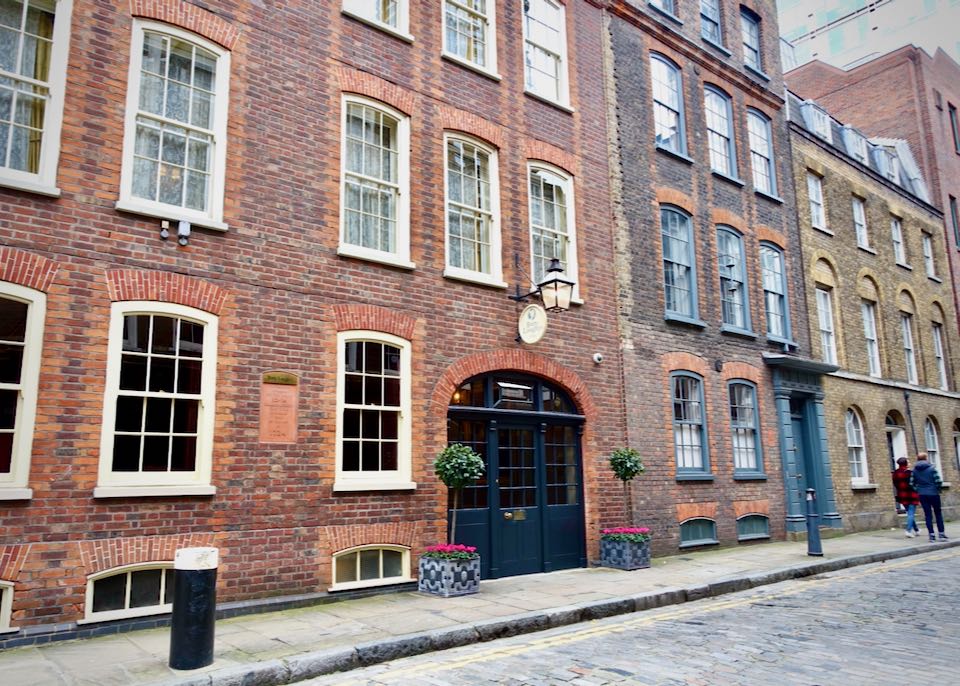
Batty Langley’s in East London is one of our very favorite boutique hotels.
- Best Neighborhood in London for a Local Vibe: Camden, Shoreditch/East End
It’s hard to get more ‘local’ than Camden. The graffiti-tagged, gritty streets still resist gentrification and, Camden Market and the tour narrow boats on Regent’s Canal aside, this is still a working-class neighborhood. Stop by Black Heart, Underworld, or another local pub and you might catch the next big thing in alternative rock. In the East End, Brick Lane is ‘Banglatown’; like other parts of east London, it retains a strong immigrant feel, with curry houses, Bangladeshi cafes, and sari shops. Though neighboring Shoreditch has been undergoing gentrification for some time now, it remains one of London’s cutting-edge neighborhoods, with a dynamic nightlife, street food, street art, and few tourists.- Best Neighborhood in London for Walking: Covent Garden/Leicester Square/Soho
The Covent Garden/Leicester Square/Soho area is easy to get around on foot. The area is crisscrossed with numerous small streets packed with restaurants, bars, and shops. There’s little traffic and very central, right in the heart of London’s West End. Trafalgar Square, the National Gallery, and the National Portrait Gallery are nearby and you can easily walk to the Houses of Parliament, the London Eye, the London Dungeon (just across the river), and Westminster Abbey. Buckingham Palace is a 15-minute walk west of Westminster – most of it away from traffic, through St James’ Park. The British Museum is a 10 to 12-minute walk north of Covent Garden.- London Without a Car
Traveling in London without a car is not only feasible, but recommended. London’s public transportation system is excellent. It includes the London underground (known as the Tube), buses, the Docklands Light Railway (DLR), overground trains, and river services. Walking is a great way to experience London’s rich history and diverse architecture. Iconic landmarks such as the Houses of Parliament, Buckingham Palace, the London Eye, and the Tower of London are within relatively short distances of each other. For longer journeys, London’s bike-sharing scheme, Santander Cycles, is a viable option. London’s famous black taxis and rideshare services like Uber are readily available, although they are often slower than the tube.My wife and I at the National Gallery.
- Safest Areas of London
London’s safest and quietest neighborhoods are typically the most affluent. Mayfair, South Kensington, Knightsbridge, Belgravia, and Chelsea are largely residential and very safe to walk around at any hour. Bloomsbury and Fitzrovia are also excellent, peaceful choices. While these areas have a very low crime rate, you should still take standard precautions after dark.- Safety & Awareness in London
Central London is generally very safe, but like any major city, it requires common sense. In areas like Camden, Shoreditch, and the South Bank, the atmosphere is vibrant and safe during the day, but can feel more chaotic late at night when the bars and clubs close. While King’s Cross and Stratford have undergone massive redevelopment and are home to excellent hotels, the immediate areas around major train stations can still attract loiterers late at night. Stick to well-lit main streets and keep an eye on your belongings in crowded areas like Leicester Square or Oxford Street, where pickpocketing is more common than anywhere else in the city.The 11 Best Areas in London for Tourists
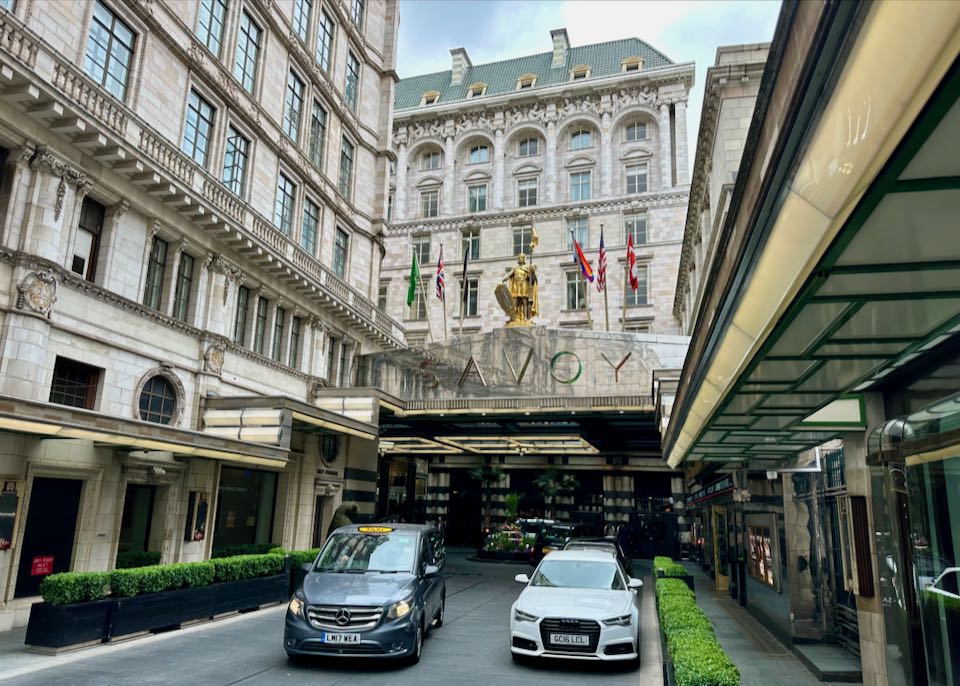
The luxurious and magical Savoy Hotel in Covent Garden.
1. Covent Garden
Covent Garden’s central feature is its cobbled piazza and restored 19th-century market, with quirky (and increasingly high-end) shops, the London Transport Museum, and a supporting cast of buskers and other street entertainment. There are plenty of restaurant bars, cafés, and pubs in the surrounding tangle of streets and several major attractions lie within easy walking distance: the Royal Opera House, Courtauld Gallery in Somerset House (which has an ice rink in winter), Leicester Square, Trafalgar Square, and the Strand. The shows and musicals of Theatreland (London’s main theatre district) form a large share of the neighborhood’s entertainment.• Hotels here tend to be expensive, though there are a handful of affordable options. Covent Garden makes an excellent base, but it is very touristy.
- Best Hotels in Covent Garden
Covent Garden Hotel • Hotel phone: +44 20 7806 1000
ME London • Hotel phone: +44 20 3499 8651
NoMad London • Hotel phone: +44 20 390 61600
One Aldwych • Hotel phone: +44 20 7300 1000
The Resident Covent Garden • Hotel phone: +44 20 3146 1790
The Savoy • Hotel phone: +44 20 7836 4343- Best Cheap/Midrange Hotels
The Fielding • Hotel phone: +44 20 7836 8305
The Z Covent Garden • Hotel phone: +44 20 3837 6304
Hotel AMANO Covent Garden • Hotel phone: +44 20 3739 89002. Kensington, Belgravia, and Chelsea
Bordered by the vast Hyde Park and Kensington Gardens to the north and Green Park to the east, these three moneyed neighborhoods are primarily known for their superb museums: the Victoria and Albert Museum, Science Museum, and Natural History Museum, the latter housing its famous dinosaur collection. There’s also Apsley House, the Duke of Wellington’s London residence, the Gothic Albert Memorial across from Royal Albert Hall, and Kensington Palace, formerly the London home of Princess Diana and now William and Kate’s residence (much of it is open to the public, however).Further west is the striking Design Museum and far less busy Leighton House Museum, a memorial to 19th-century painter Lord Leighton and his Pre-Raphaelite friends. The Knightsbridge neighborhood contains London’s most upmarket department stores – Harrods and Harvey Nichols – and if you’re serious about fashion, Elizabeth Street in Belgravia is lined with powerhouse designer outlets. Over in Chelsea, the Kings Road was hip in the 1960s and punk in the 1970s (it’s much tamer today), while the Saatchi Gallery, Royal Hospital (home of the Chelsea flower showgrounds), and National Army Museum provide added interest. The dining scene includes some of London’s finest restaurants.
• As you’d expect these areas contain some of the most luxurious and expensive hotels in the city, getting cheaper the further west you go (especially along Cromwell Road into Earl’s Court and West Brompton). Staying out here is generally quieter than Central London, but it’s easy to visit thanks to excellent public transport.
- Best Hotels in Kensington, Belgravia, and Chelsea
Ampersand Hotel • Hotel phone: +44 20 7589 5895
The Berkeley • Hotel phone: +44 20 7235 6000
Bulgari Hotel London • Hotel phone: +44 20 7151 1010
The Cadogan • Hotel phone: +44 20 7048 7141
Mandarin Oriental Hyde Park • Hotel phone: +44 20 7235 2000
San Domenico House • Hotel phone: +44 20 7581 5757- Best Cheap/Midrange Hotels
Ashburn Hotel • Hotel phone: +44 20 7244 1999
London Visitors Hotel • Hotel phone: +44 77 7850 5544
The Queen’s Gate • Hotel phone: +44 20 7584 7222
Sydney House Chelsea • Hotel phone: +44 20 7376 7711- Best Hostels
Barmy Badger Backpackers • Hotel phone: +44 20 7370 5213
Safestay Kensington Holland Park • Hotel phone: +44 20 7870 9629
YHA Earl’s Court • Hotel phone: +44 345 371 9114
3. Westminster and St James’s
Sandwiched between the River Thames, Mayfair, Belgravia, and Soho, Westminster is Britain’s seat of power. Restaurants and accommodations here are few, but London’s biggest attractions are concentrated in this central part of the city, including the Houses of Parliament and Big Ben, the Tate Britain art gallery, and Trafalgar Square – home to Nelson’s Column, iconic St Martin-in-the-Fields church, National Portrait Gallery and the National Gallery. Connecting Trafalgar Square with Parliament Square is elegant Whitehall, a broad avenue lined with imposing statues and monuments, including the Cenotaph, a memorial to the nation’s war dead. Just off here is No.10 Downing Street, the home of the British Prime Minister, and the Churchill War Rooms (where Winston Churchill directed operations in World War II). There’s a strong royal connection as well: Buckingham Palace in St James’s Park is His Majesty’s home and office, while Westminster Abbey is the coronation and burial place of British monarchy.• This is where to view “Changing the Guard” ceremonies: the Foot Guards at Buckingham Palace, and the Household Cavalry at Horse Guards on Whitehall (Mon–Sat 11am, Sun 10am).
• Cheap hotels lie south and east of Victoria Station (Belgrave Rd), otherwise it’s very expensive to stay in Westminster and St James themselves.
- Best Hotels in Westminster and St James’s
Conrad St. James • Hotel phone: +44 20 3301 8080
Corinthia London • Hotel phone: +44 20 7930 8181
The Goring • Hotel phone: +44 20 7396 9000
The Guardsman • Hotel phone: +44 20 7309 9200
Hotel 41 • Hotel phone: +44 20 7300 0041
The Ritz • Hotel phone: +44 20 7493 8181
The Stafford • Hotel phone: +44 20 7493 0111
Taj 51 Buckingham Gate • Hotel phone: +44 20 7769 7766
The Trafalgar • Hotel phone: +44 20 7870 2900- Best Cheap/Midrange Hotel
Citadines Trafalgar Square • Hotel phone: +44 20 7766 3700
hub Westminster Abbey • Hotel phone: +44 333 321 3104
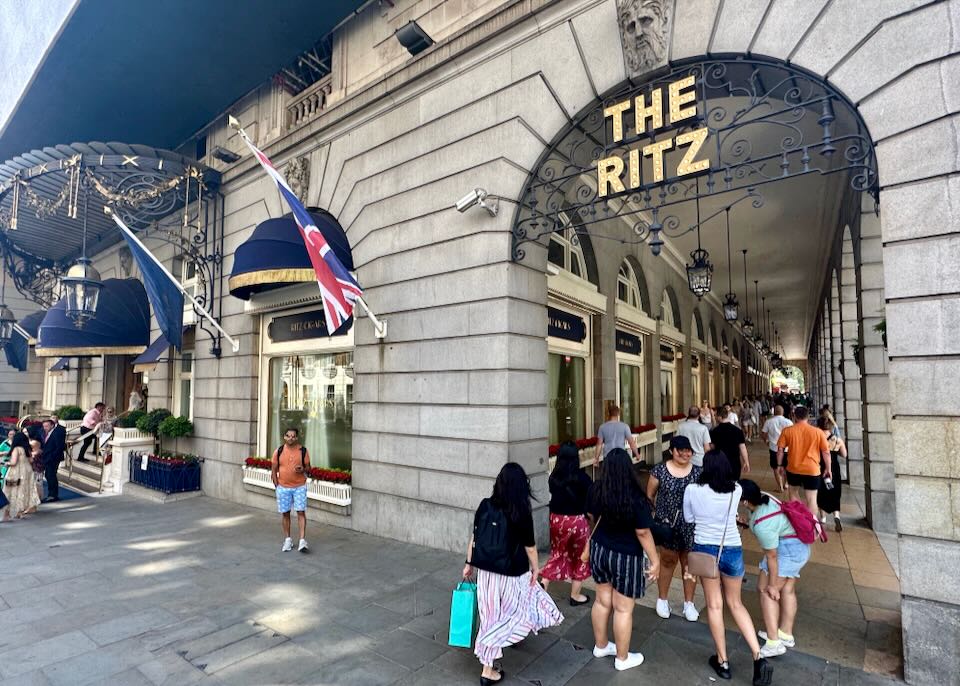
The legendary Ritz Hotel on Piccadilly, an enduring symbol of elegance and British tradition. Staying here is a truly opulent experience, from the white-gloved doormen to the famed afternoon tea in the Palm Court. It’s not just a hotel; it’s a London institution.
4. Soho
Bars, clubs, and a diverse clutch of restaurants are the hallmarks of Soho, London’s liveliest nightlife area and former red-light district. Centrally located and an easy walk away from the river and several major attractions, Soho is also the heart of London’s LGBTQA+ scene (especially vibrant around Old Compton St), and one of the best parts of London for independent designers and record stores. Soho is bordered to the south by the small, bustling Chinatown (the main drag is Gerrard Street, with its traditional Chinese gates) and touristy Leicester Square, famous for its movie premieres. A short stroll west is the equally touristy junction of Piccadilly Circus with its neon billboards and the Shaftesbury Memorial Fountain’s “Eros” statue (it’s actually Anteros). Other highlights include venerable jazz club Ronnie Scott’s, the street market on Berwick Street, the shops on and around 1960s icon Carnaby Street, the Photographers’ Gallery, and the grand old Liberty department store.• Soho is always very busy but staying here means you’ll have the best nightlife and dining scene at your doorstep, along with easy access to some of the main sights and shopping districts in the city. As a result, rates tend to be very expensive, though there are a several good budget options, noted below.
The Z Soho is good value and has a great central location.
- Best Hotels in Soho
The Resident Soho • Hotel phone: +44 20 3697 3697
The Soho • Hotel phone: +44 20 7559 3000
Ham Yard • Hotel phone: +44 20 3642 2000
Hazlitt’s • Hotel phone: +44 20 7434 1771- Best Cheap/Midrange Hotels
The Z Soho • Hotel phone: +44 20 3551 3701
hub Soho • Hotel phone: +44 333 321 3104
Premier Inn Leicester Square • Hotel phone: +44 333 321 9254- Best Hostel
YHA Oxford Street • Hotel phone: +44 20 7734 16185. City of London (The City)
Studded with London’s relatively recent crop of skyscrapers, the financial heart of the city has a 2000-year-old history. This is where the Romans originally founded Londinium in 47 AD, and no other part of London packs so many heavyweight attractions into so small a space as the “Square Mile” (despite the destruction wrought by the Great Fire of 1666 and the German Blitz in World War II). Besides Roman ruins, St Paul’s Cathedral, and the Tower of London (with its iconic “Beefeaters” and Crown Jewels), Tower Bridge (you can walk across the elevated walkways), Wren’s soaring Monument to the Great Fire, the medieval Guildhall, London’s oldest synagogue, and the modern but illuminating Museum of London and the Barbican arts complex, there are numerous churches here loaded with history – some medieval, others built by Sir Christopher Wren, but all well worth exploring (St Bride’s, St Olave’s and All Hallows by the Tower are especially interesting). For a taster of the modern financial district, visit Rafael Viñoly’s “Walkie Talkie” building on Fenchurch Street, which features the popular public Sky Garden on the top floor, with several restaurants and bars (it’s best to book ahead).Other highlights include the Bank of England Museum, Dr Johnson’s House, the Charterhouse, Smithfield Market, the Museum of the Order of Saint John, and the fantastic dining in Clerkenwell. The City is also littered with historic pubs like Ye Olde Cheshire Cheese and the Old Bell Tavern, all dripping with character. There is also one of the city’s finest small museums in Holborn, at the western end of the district: Sir John Soane’s Museum with its fascinating art collections. Nearby are the Inns of Court, where Britain’s top lawyers train and ply their trade, and Temple Church, built in 1185 by the Knights Templar and made famous by Dan Brown’s The Da Vinci Code.
• There are some excellent budget options here, though The City can be quiet at nights and on weekends (apart from Clerkenwell and into Islington). This part of London has a very different feel to the West End, with the juxtaposition of medieval and Roman remains with glass and steel skyscrapers quite jarring.
- Best Hotels in The City of London
Four Seasons at Ten Trinity Square • Hotel phone: +44 20 3297 9200
The Ned • Hotel phone: +44 20 3828 2000
Pan Pacific London • Hotel phone: +44 20 3297 9200
The Rookery • Hotel phone: +44 20 7336 0931
Rosewood London • Hotel phone: +44 20 7781 8888
Vintry and Mercer • Hotel phone: +44 20 3908 8088- Best Cheap/Midrange Hotels
Apex Temple Court • Hotel phone: +44 20 3004 4141
citizenM Tower of London • Hotel phone: +44 20 3519 4830
Motel One • Hotel phone: +44 20 7481 6420
hub City Bank • Hotel phone: +44 871 527 8000
hub Tower Bridge • Hotel phone: +44 871 527 9576
Premier Inn Blackfriars • Hotel phone: +44 333 321 9269- Best Hostels
Wombat’s City Hostel • Hotel phone: +44 20 7680 7600
YHA St Paul’s • Hotel phone: +44 345 371 9012
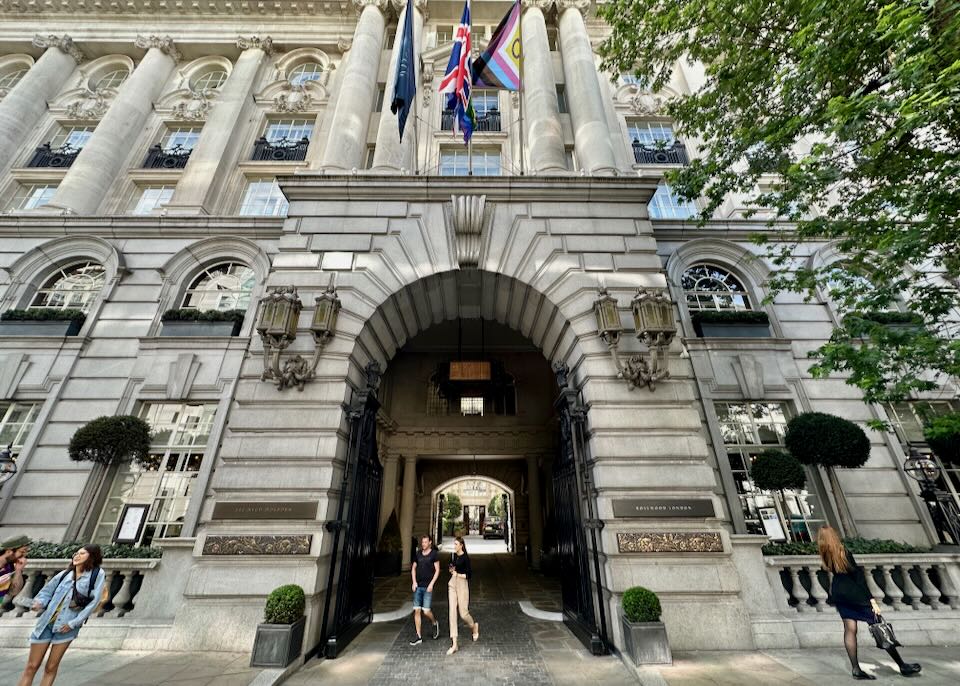
The grand entrance of the Rosewood London in Holborn. Walking through the magnificent archway and into the hotel’s quiet inner courtyard feels like entering a private palace.
6. Mayfair and Marylebone
Lined with high street fashion outlets and the iconic Selfridges department store, centrally located Oxford Street bisects two distinguished neighborhoods. To the north is fashionable Marylebone, attracting moneyed Londoners with its designer shops and upmarket eateries (especially along Marylebone High Street, with its village-like feel), while the ever-popular waxworks of Madame Tussauds, just south of Regent’s Park, panders to crowds of visitors (book online). The area also contains an excellent (and rarely busy) art gallery, the Wallace Collection, plus the Sherlock Holmes Museum on Baker Street, at the fictional home of the famous detective. South of Oxford Street, Mayfair oozes class and wealth, its grid of tree-lined streets dotted with 5-star hotels, antique shops, boutiques along Bond Street, and the finest menswear outlets in town along its famous shopping street, Saville Row. Posh Piccadilly forms Mayfair’s southern boundary, home to elegant Burlington Arcade, Fortnum & Mason, and the Royal Academy of Arts.• Mayfair is an expensive area, but for good reason – quiet and posh neighborhoods but conveniently central. You’ll get better deals in Marylebone, though note that the cheapest hotels here are poor value – you get what you pay for.
Perfectly located in Mayfair, The Athenaeum sits directly on Piccadilly overlooking the beautiful expanse of Green Park, just a short walk from Buckingham Palace.
- Best Hotels in Mayfair and Marylebone
The Athenaeum • Hotel phone: +44 20 7499 3464
The Beaumont • Hotel phone: +44 20 7499 1001
Claridge’s • Hotel phone: +44 20 7629 8860
The Connaught • Hotel phone: +44 20 7499 7070
The Dorchester • Hotel phone: +44 20 7629 8888
Four Seasons at Park Lane • Hotel phone: +44 20 7499 0888
The Langham • Hotel phone: +44 20 7636 1000
The Marylebone • +44 20 7486 6600- Best Cheap/Midrange Hotel
The Z Gloucester Place • Hotel phone: +44 20 3551 37197. East London
East of The City, the East End used to have a bad reputation, with its Victorian slums, Jack the Ripper and the Kray twins stalking the streets, and the squalor surrounding London’s docks and heavily industrialized neighborhoods. The East End retains its immigrant neighborhoods and lively ethnic vibe, but today it’s one of the most dynamic parts of the city, with hip craft breweries, art galleries and murals, boutique hotels, and a cutting-edge club scene.Must-visits include Spitalfields Market and the excellent restaurants surrounding it, the Whitechapel Gallery, the Brick Lane Sunday flea market’s Bangladeshi curry houses and vintage fashion shops, the designer shops and hip Boxpark of Shoreditch, and Hoxton’s frenetic nightlife. You can sample Cockney classics like eel pie and mash and fish and chips, and sip beer in historic pubs like the Kray twins’ Carpenter’s Arms, Lord Nelson’s favorite The Gun, and the Ten Bells (associated with Jack the Ripper). Further out towards Stratford lies the Queen Elizabeth Olympic Park, focus of the London 2012 Olympic and Paralympic Games. In addition to seeing Zaha Hadid’s wavy Aquatics Centre, you can climb Anish Kapoor’s twisting red ArcelorMittal Orbit tower for spectacular views across London, and try its thrilling “Orbit slide”.
Docklands & Canary Wharf
The vast Docklands of East London were largely abandoned by the 1970s, but since the 1990s have been spectacularly transformed into zones of condos, offices, and marinas along the river. Canary Wharf on the Isle of Dogs, with its banks and skyscrapers, has effectively become London’s second financial district after the City. Though there’s not a lot to see (other than the high-rise architecture), curious tourists still pay a visit, strolling along the canals and through subterranean shopping malls. Discover the city’s maritime past at the Museum of London Docklands, or take the IFS Cloud Cable Car from Royal Victoria Dock to the O2 (formerly the Millennium Dome) on the Greenwich Peninsula on the other side of the Thames. It’s not a great idea to stay in Canary Wharf, but the Hilton, Novotel, and Marriott are all excellent options. For the O2, there’s the InterContinental.• East London generally contains much cheaper, edgier neighborhoods, where you’ll be mixing with more locals than tourists. There are some great deals on hotels to be had here, especially with boutiques in Shoreditch.
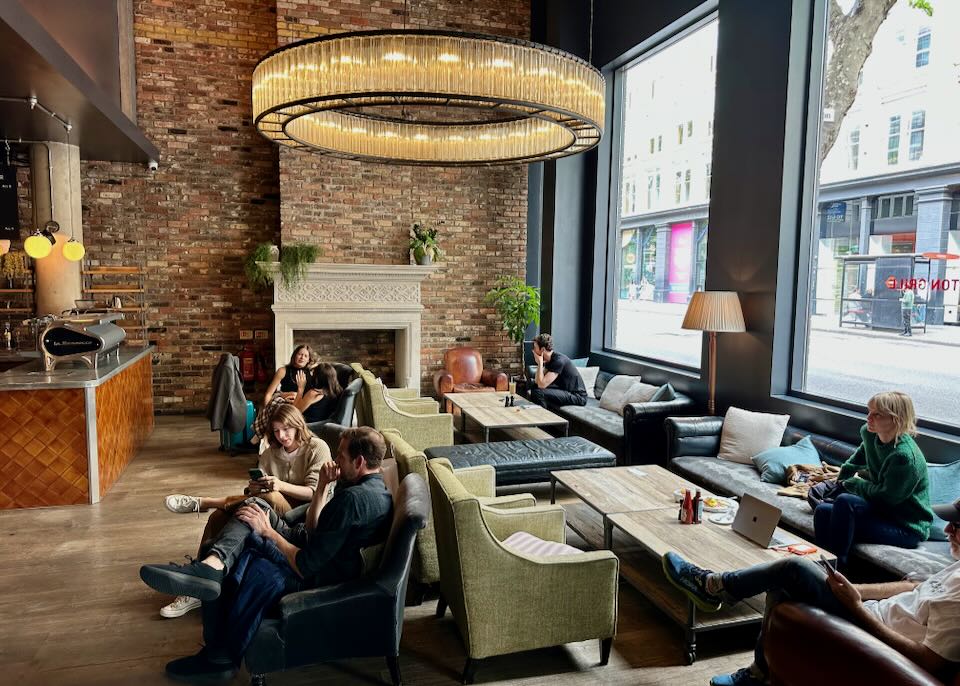
The good-value The Hoxton, Shoreditch, an easy walk to the Old Street tube station.
- Best Hotels in East London
Batty Langley’s • Hotel phone: +44 20 7377 4390
Hart Shoreditch • Hotel phone: +44 20 3995 3655
The Hoxton, Shoreditch • Hotel phone: +44 20 7550 1000
Redchurch Townhouse • Hotel phone: +44 20 3819 8180- Best Cheap/Midrange Hotels
The Corner London City • Hotel phone: +44 20 3021 3300
Holiday Inn Whitechapel • Hotel phone: +44 20 7791 9010
ibis London City Shoreditch • Hotel phone: +44 20 7422 8400
The Z Shoreditch • Hotel phone: +44 20 3551 3702
hub Spitalfields, Brick Lane • Hotel phone: +44 871 527 9588- Best Hostel
Park Villa Boutique Hostel • Hotel phone: +44 20 8980 1439
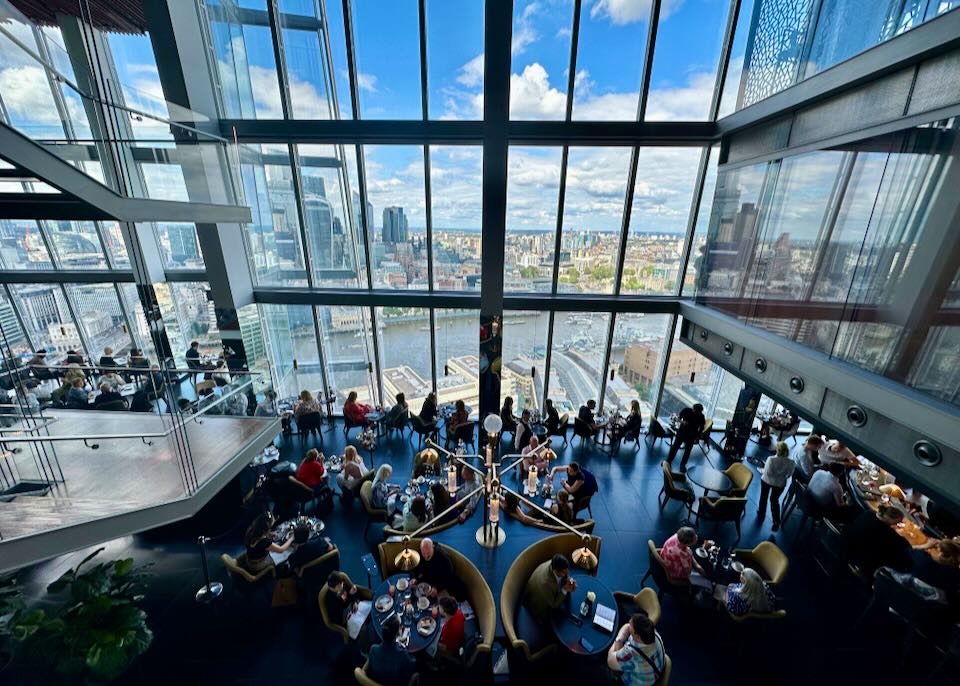
The awesome views from Shangri-La The Shard from its perch on the south side of the Thames.
8. South Bank
The Thames is London’s lifeblood, and many of the city’s attractions are concentrated along the revamped promenade that stretches along the river’s South Bank in central London – from Shakespeare’s Globe and the Southbank Centre (Europe’s largest arts venue), and the Tate Modern, the country’s top contemporary (and free) art gallery, to the London Eye (the largest Ferris wheel in Europe) and the Shard skyscraper’s observation deck. Families will want to check out the London Dungeon, Sea Life Aquarium, and replica of Drake’s Golden Hinde ship. Other highlights include battleship-turned-museum HMS Belfast, the White Cube art gallery, medieval Southwark Cathedral, Florence Nightingale Museum, and the excellent Imperial War Museum. Dining options include the standout Borough Market, which is crammed with food stalls, as well as the smaller Maltby Street Market.• Waterloo station and London Bridge are both major transport hubs that serve this area.
• You’ll find a lot of excellent modern midrange hotels here from the Park Plaza, Ibis, Premier Inn and Citizen hotel chains.
The Park Plaza Westminster Bridge is close to many top attractions and a great hotel for families.
- Best Hotels on London’s South Bank
Bankside Hotel • Hotel phone: +44 20 3319 5988
Hilton Bankside • Hotel phone: +44 20 3667 5600
The Hoxton, Southwark • Hotel phone: +44 20 7903 3000
Marriott County Hall • Hotel phone: +44 20 7928 5200
Shangri-La The Shard • Hotel phone: +44 20 7234 8000
Sea Containers • Hotel phone: +44 20 3747 1000- Best Cheap/Midrange Hotels
citizenM Bankside • Hotel phone: +44 20 3519 1680
H10 Waterloo • Hotel phone: +44 20 7928 4062
ibis Blackfriars • Hotel phone: +44 20 7633 2720
Novotel London Bridge • Hotel phone: +44 20 7089 0400
Park Plaza County Hall • Hotel phone: +44 333 400 6116
Park Plaza Westminster Bridge • Hotel phone: +44 333 400 6112
Ruby Lucy • Hotel phone: +44 20 3475 3460- Best Hostel
The Walrus Bar & Hostel • Hotel phone: +44 20 7928 43689. Camden Town and Primrose Hill
Grungy and rough around the edges, Camden Town nestles in the northeast reaches of Regent’s Park, near the family favorite London Zoo. It’s centered on the sprawling Camden Market – four adjoining markets selling anything from vintage clothing and records to art and gourmet street food (there’s also a beloved statue of late singer Amy Winehouse). You can also take boat rides (or stroll the path) along the canals from here to Little Venice, or visit the Jewish Museum, charting the history and culture of the British Jewish community. The birthplace of British rock music, Camden has a young, studenty vibe, numerous live music venues, and lively pubs, while Primrose Hill, just to the west, is a celeb hangout with artisan coffee shops, gastropubs, and chic stores – climb the grassy hill itself for panoramic views across the whole city.• These are hip areas to stay in, off the main tourist trail, but with far fewer hotels (apartment rentals may be the way to go here).
- Best Hotels in Camden Town and Primrose Hill
Holiday Inn Camden Lock • Hotel phone: +44 20 7485 4343
Marriott Regents Park • Hotel phone: +44 20 7722 7711- Best Cheap/Midrange Hotels
The Hurdwick • Hotel phone: +44 7487 659744
Primrose Guesthouse • Hotel phone: +44 7735 55009810. Bloomsbury, Fitzrovia and King’s Cross
The bookish and offbeat neighborhoods of Bloomsbury and Fitzrovia are just north of Oxford Street. Bloomsbury is centered around the University of London and the enormous British Museum – the UK’s best – which is surrounded by a buzzy grid of streets filled with cafes and restaurants. Other highlights include Charles Dickens Museum, former home of the beloved writer, and the museums on the university campus: Grant Museum of Zoology, the Wellcome Collection of medical artifacts and oddities, and Petrie Museum of Egyptian Archaeology. Just west of Bloomsbury is trendy Fitzrovia – short on sights but with lively pubs and bars frequented by young professionals. To the north is the regenerated King’s Cross, with the international rail hub of St Pancras, the Harry Potter Shop at Platform 9¾ (in King’s Cross station itself), some excellent street food, and the British Library, housing the Lindisfarne Gospels and the Magna Carta.• Hotels tend to be good value here, but note that the cheapest hotels are not good value. It’s a little more sedate, though the student population livens things up a bit.
- Best Hotels in Bloomsbury, Fitzrovia and King’s Cross
The Bloomsbury • Hotel phone: +44 20 7347 1000
Kimpton Fitzroy • Hotel phone: +44 20 7123 5000
The London EDITION • Hotel phone: +44 20 7781 0000
Mandrake • Hotel phone: +44 20 3146 7770
Montague on the Gardens • Hotel phone: +44 20 7637 1001
St. Pancras Renaissance • Hotel phone: +44 20 7841 3540- Best Cheap/Midrange Hotels
Morton Hotel • Hotel phone: +44 20 7692 5600
hub Goodge Street • Hotel phone: +44 333 321 3104
hub King’s Cross • Hotel phone: +44 333 321 3104
Premier Inn King’s Cross • Hotel phone: +44 333 321 1272- Best Hostels
Astor Museum Hostel • Hotel phone: +44 20 7580 5360
Clink261 • Hotel phone: +44 20 7183 9400
YHA London Central • Hotel phone: +44 345 371 9154
YHA St Pancras • Hotel phone: +44 345 371 9344
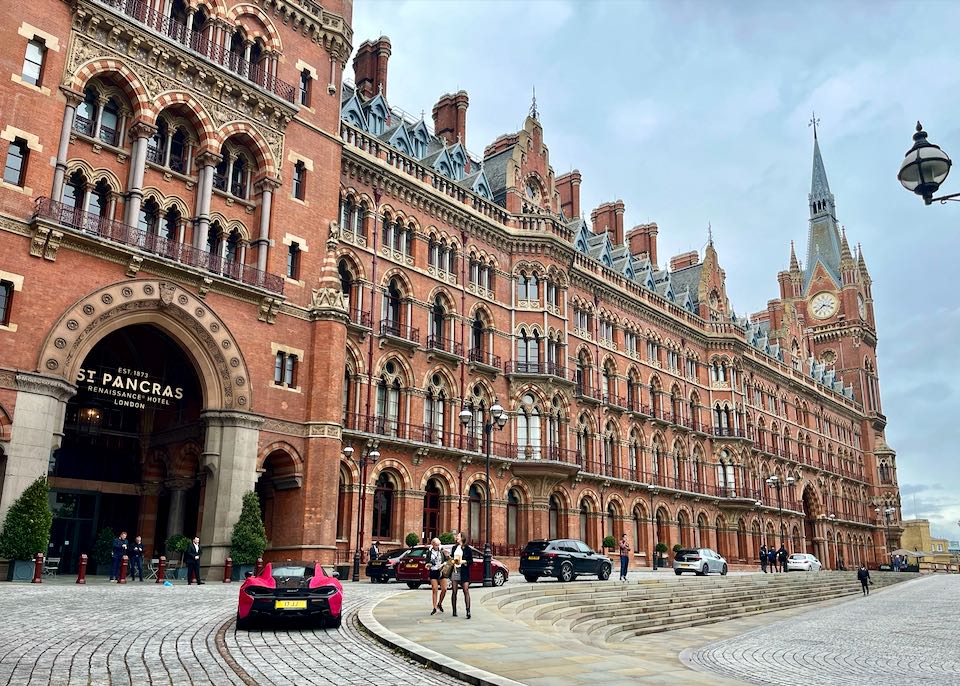
Just north of Bloomsbury, sits the iconic St. Pancras Renaissance at King’s Cross/St. Pancras railway station (with direct trains to Cambridge, Edinburgh, Paris, Amsterdam, and many more).
11. Greenwich
Boats along the Thames give easy access to attractions in other parts of London, including Greenwich, further east – a UNESCO World Heritage collection of museums. Known for giving its name to Greenwich Mean Time, you can see the east-west Prime Meridian Line at the Royal Observatory at the top of Greenwich Park (which also provides the best views of the skyscrapers at Canary Wharf). Back down by the river, the Cutty Sark is the main attraction, the world’s last surviving tea clipper, along with the picturesque buildings of the Old Royal Naval College (designed by Christopher Wren and now primarily used by the University of Greenwich) – the murals in the Painted Hall are definitely worth seeing. Aficionados of naval history will love the National Maritime Museum, which also includes Inigo Jones’s Queen’s House, designed in 1616 for James I’s wife, Anne of Denmark. Greenwich also offers plenty of places to eat and drink, as well as indoor Greenwich Market for gifts and antiques.• Greenwich is worth a full day trip if you have time (easy via public transport), but there are a few decent hotels here if you fancy staying longer: the Admiral Hardy in the center, or the modern Novotel Greenwich and Staycity Greenwich High Road a little further out.
Other London Neighborhoods
We’ve covered our favorite neighborhoods to visit and stay in more detail above, but London is a vast, attraction-packed city and with more time, the following areas are also worth checking out:
- North London: Kids and Harry Potter fans in general will love The Making of Harry Potter tour at the Warner Bros studios in Leavesden (20 miles northwest of central London). Take the train to Watford Junction where shuttle buses (included in the price) zip to the studios. Soccer fans can make the pilgrimage to Wembley Stadium, the home of English football, for tours and major concerts. There are some good hotels here: the Premier Inn London Wembley Stadium is usually an excellent value.
- South London: Tennis fans will want to visit the Wimbledon Lawn Tennis Museum (the Wimbledon Tennis Tournament itself takes place in July), while the history of gin is chronicled at the Beefeater Gin Distillery in Kennington. Further south, art fans should check out the collection at Dulwich Picture Gallery (which includes Rembrandt’s famed Girl at a Window), while the quirky Horniman Museum contains unusual natural history and ethnographic exhibits.
- West London: Made globally famous by the 1999 movie of the same name, affluent Notting Hill lies in West London and is best known for its colorful Victorian townhouses and the Notting Hill Carnival, Europe’s biggest street festival (held every August). It’s also home to the iconic Portobello Road Market, a vast emporium of fashion, gifts, antiques, and street food. You could spend another week seeing the sights along the River Thames west from central London. Kew is the home of the beautifully maintained Royal Botanic Gardens and 17th-century Kew Palace, while Syon House is another huge stately home just across the river with an opulent 18th-century interior. Nearby Richmond is a charming river town that will be familiar to fans of hit TV show Ted Lasso, with the World Rugby Museum and Twickenham Stadium Tours on the other side of the Thames. Henry VIII’s Hampton Court Palace further south is one of England’s most famous royal palaces. Finally, it’s an easy day-trip out to Windsor to visit the massive royal castle, Eton College, and the site of the Magna Carta signing at Runnymede. The Macdonald Windsor Hotel and Castle Hotel Windsor are good central choices here. The Bingham Riverhouse is a romantic option in Richmond.
- There’s not much point in staying at the airports unless you have an early flight (or are arriving very late) and are traveling by public transport; it can be time consuming to travel from central London, especially to/from Gatwick and Stansted. At Heathrow, the Sofitel Heathrow is the best and most convenient, if expensive. Nearby Leonardo and Renaissance hotels are usually much cheaper. At Stansted we like the ultra-convenient Hampton. At Gatwick the Sofitel Gatwick (north terminal) is the best. And Bloc Hotel and YOTELAIR (South Terminal) are solid, convenient options.
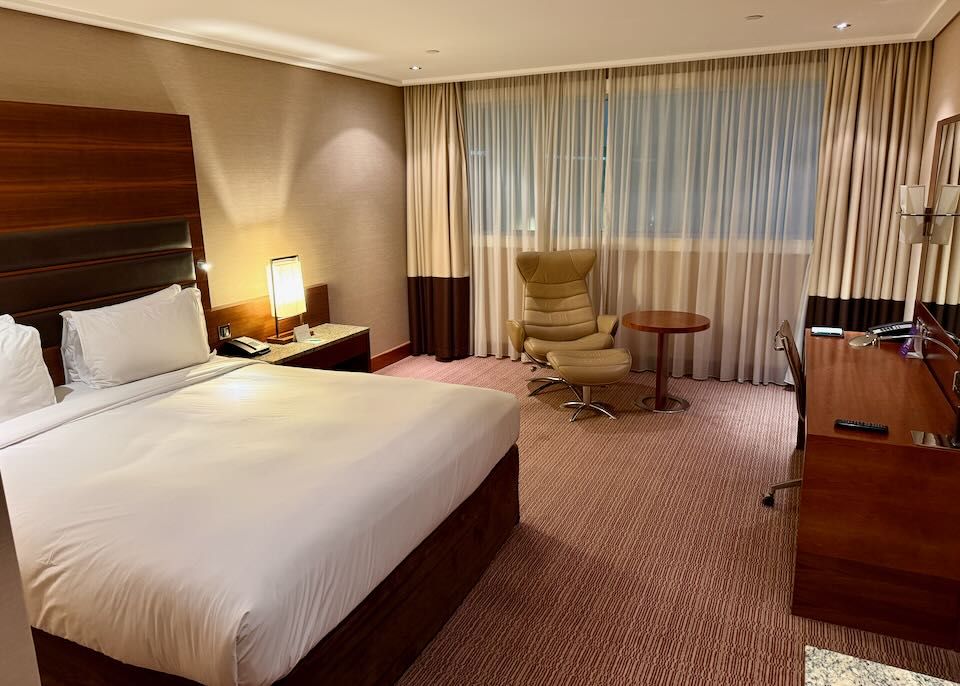
Our room at the Sofitel Heathrow. Direct indoor access to Terminal 5.
England’s Premier League is popular worldwide, and though tickets are not cheap, watching a football (soccer) game at one of the major London clubs can be a memorable experience. Don’t even think about driving to a game: take a train or the Underground. Most clubs also offer stadium tours and have on-site museums displaying the silverware.
- Arsenal plays at the Emirates Stadium in Holloway, North London, served by the Arsenal, Highbury & Islington and Holloway Road Underground stations.
- Chelsea play at Stamford Bridge in Fulham, West London, with Fulham Broadway the closest Underground.
- Tottenham play at Tottenham Hotspur Stadium in North London, close to the White Hart Lane Overground station, plus the Seven Sisters and Tottenham Hale Underground stops.
- Other London Premiership clubs include West Ham (who play at the Olympic stadium in East London), Crystal Palace in South London, and Brentford and Fulham (both West London).
London Travel Tips
- London is served by three primary airports – Heathrow, Gatwick and Stansted – with smaller airports like Luton, London Southend and London City serving a few domestic and European destinations. The best way into the city from the main three airports is to take the train (or Underground from Heathrow); taxis are readily available but expensive.
- There are several tourist discount cards available for London. If you only intend to visit a few sights or just London’s free museums and galleries (Tate Modern, British Museum), it’s usually not worth buying one. Otherwise, you’ll need to do some research to maximize your savings.
– The all-inclusive London Pass (1, 2, 3, 4, 5, 7 or 10 days) is valid at over 90 sights (but NOT the London Eye and Madame Tussauds) and is a good idea for families intending to see at least 3 major attractions (not museums) per day.
– The London City Pass from Turbo Pass is similar but offers a free public transport option, which is useful, but overall is better for visitors staying longer, around 7 days.
– The London Sightseeing Pass doesn’t include as much as the others, BUT is a bit cheaper and not bad for short trips and for visitors who like bus and boat tours.
– We also like the Go City London Explorer Pass, which is based on the number of attractions and activities you choose, instead of the number of days, so assuming you know exactly want you want to do, can be cheaper.- Bike rental is available through bikeshare outfits like Santander Cycles. London is not a bad place to ride bikes, offering plenty of bike lanes and “leisure cycle routes”; but with public transport so efficient, it’s not worth renting a bike just to get around – unless you really enjoy riding them and intend to explore the leisure routes more extensively. Dott, Lime and TIER offer shared e-scooters around the capital.
- Free wi-fi is available at Heathrow, Gatwick and Stansted airports, and throughout The City district (look for “O2 Wi-Fi”). It’s also available at most Underground stations, museums/galleries, and libraries throughout the city, as well as at almost every café and restaurant.
- Tipping: unlike the US, tips in the UK are discretionary and depend on the quality of the service. In London, it’s usual to leave 10–15% of the check (“bill”) when eating out, though if a service charge has been added instead (which does happen) there’s no need to tip. Locals also tend to round taxi fares to the nearest pound. Do not tip the bartender in a pub, though.
London’s Main Transport Options
- The Tube (Underground): This is the fastest way to travel across the city. The network is extensive and connects all major neighborhoods and attractions. Fares are based on the zones you travel through.
- Double-Decker Buses: Don’t overlook the iconic red buses. They are excellent for shorter journeys and offer a fantastic view of the city streets. Buses have a single flat fare per journey, and the “Hopper Fare” allows you to take unlimited bus or tram trips within one hour for no extra charge.
- Other Trains (DLR, Overground, Elizabeth Line): These are other train lines that are fully integrated into the main transport system. Your contactless card or phone works seamlessly across all of them. The Elizabeth Line is a new, fast line connecting Heathrow Airport, Central London, and areas to the east.
- River Bus (Uber Boat by Thames Clippers): This is a scenic way to travel along the River Thames. It is more expensive than the Tube or bus and is not fully included in the daily/weekly fare cap, but using your contactless card or phone gives you a discount over the standard ticket price.
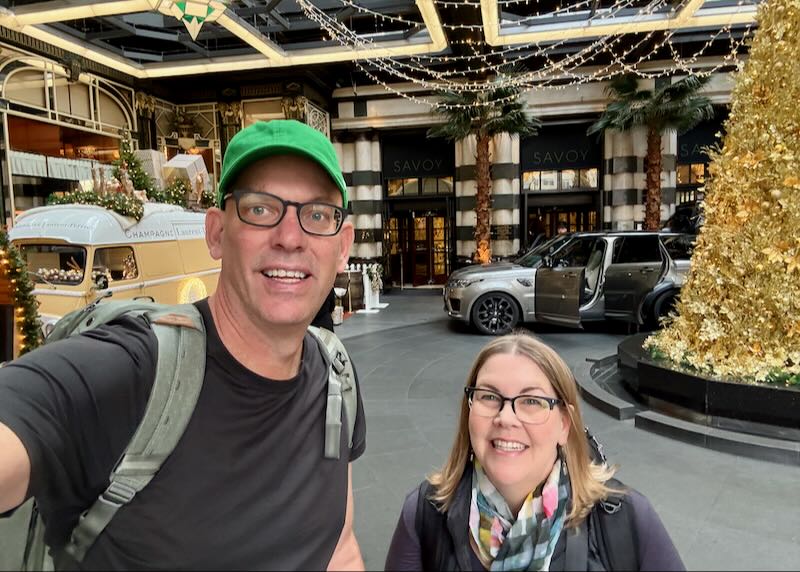
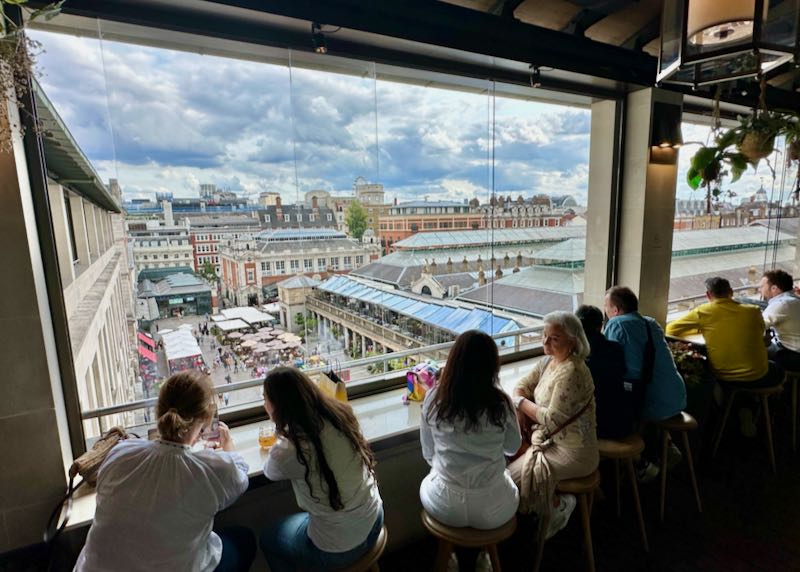
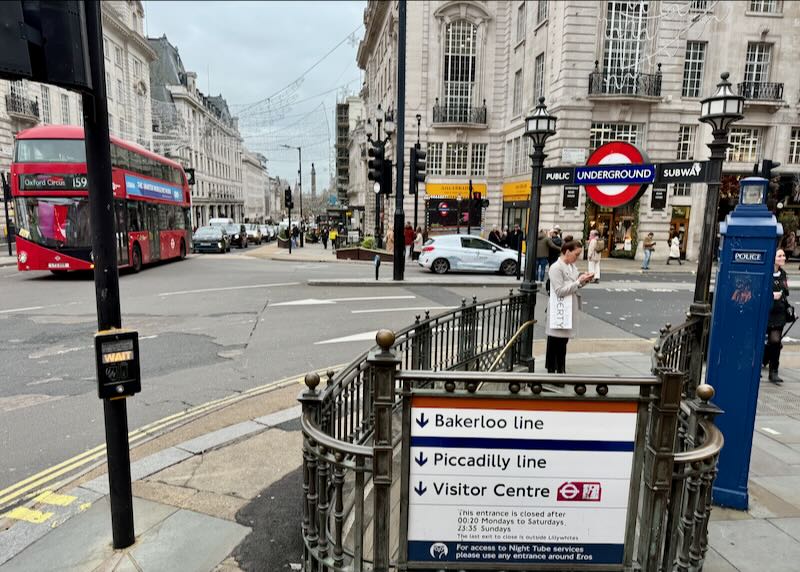
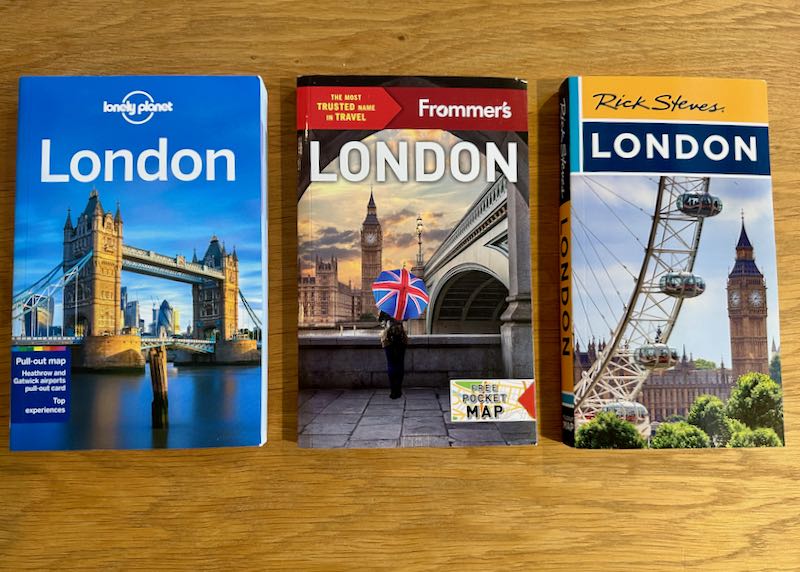
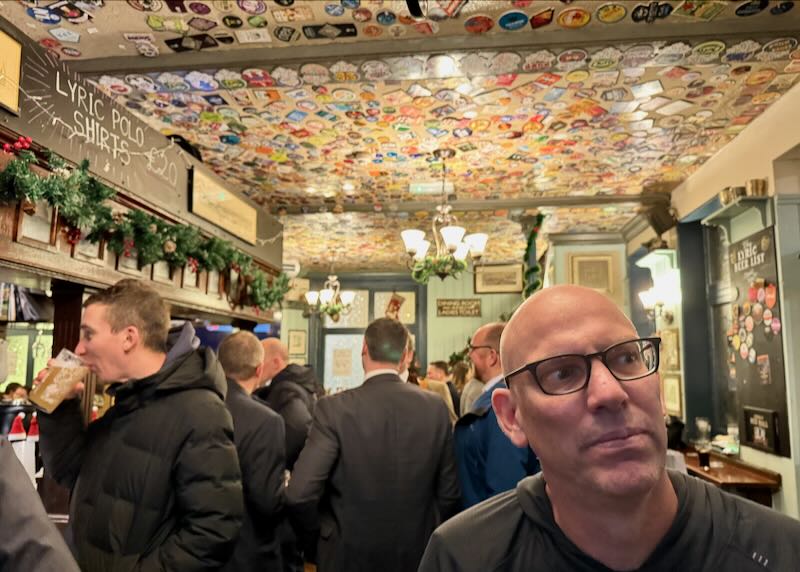
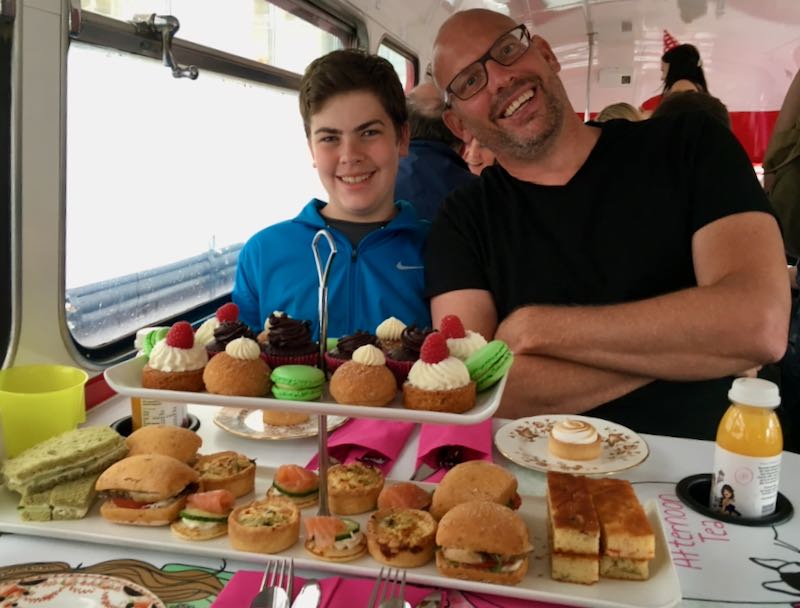
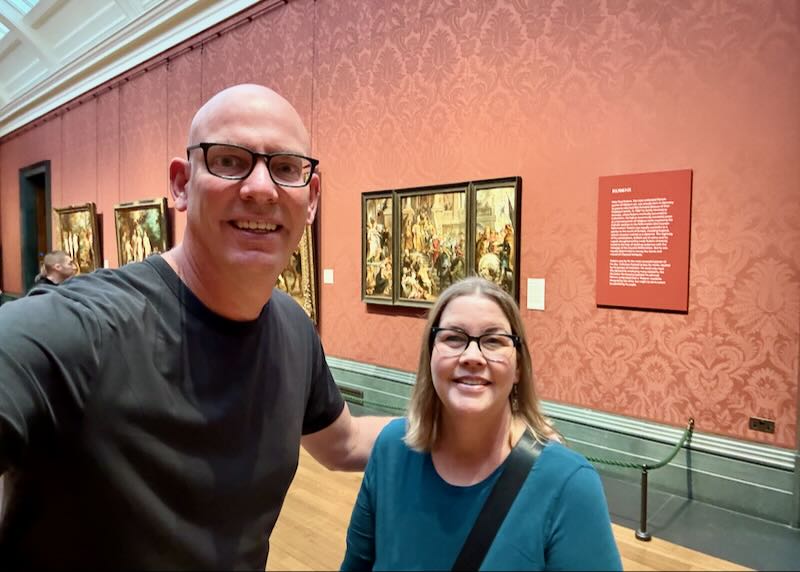


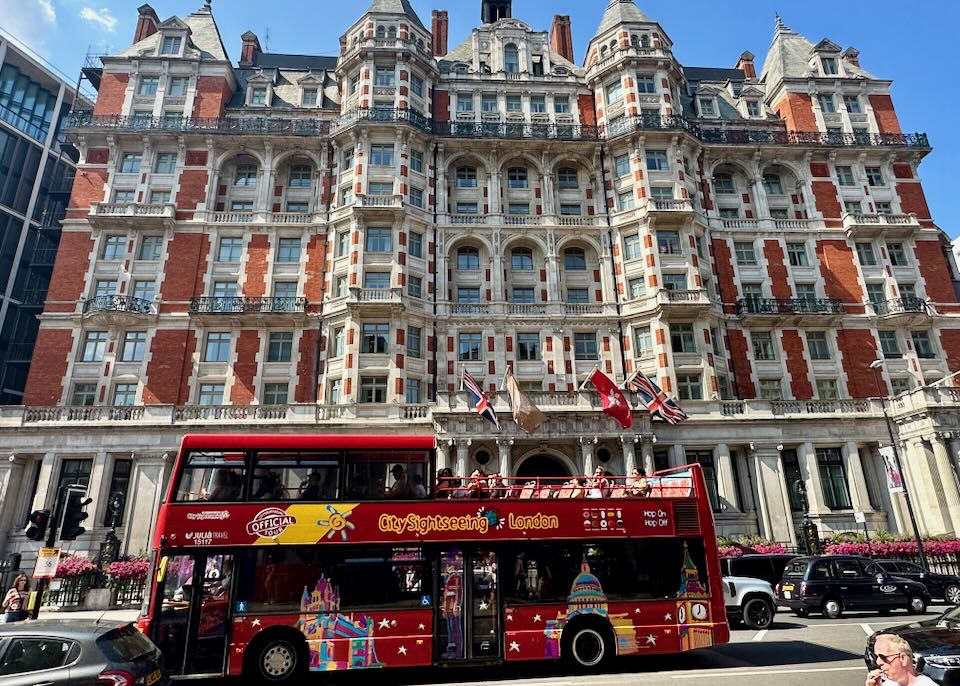


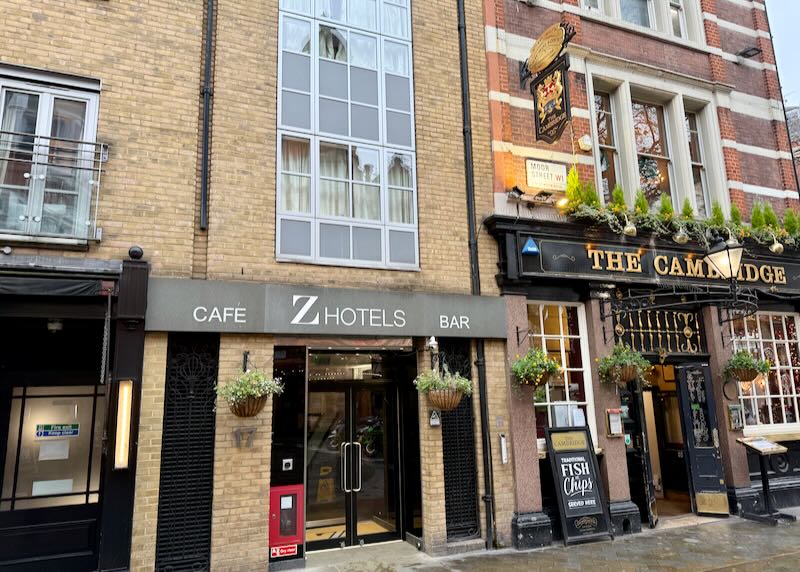


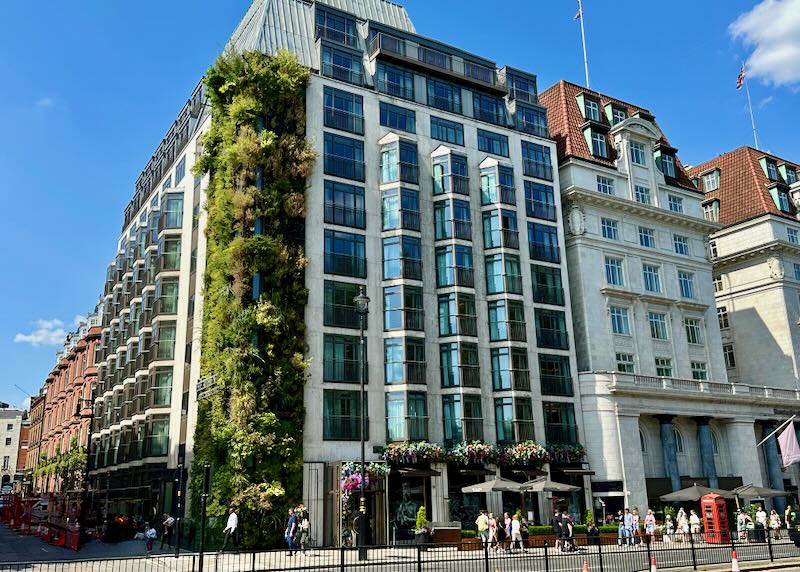


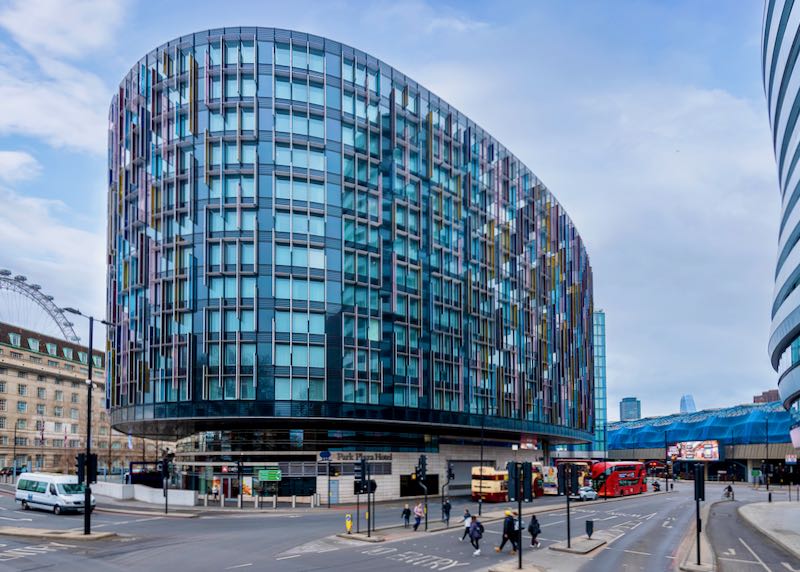



 Santorini Dave was started in 2011 when I posted a short guide to visiting Santorini with kids. Now, my site publishes regularly updated guides to
Santorini Dave was started in 2011 when I posted a short guide to visiting Santorini with kids. Now, my site publishes regularly updated guides to
My husband and I are planning a first time visit to London next Spring. We are both 70 year old seniors and husband walks with a cane. We plan to visit some popular central London historic sites but also want to visit Bletchly Park and Stonehenge which are not located in Central London. Due to limited mobility we are planning slow travel over 10 days. Probably one, maybe 2 attractions per day. We are not opposed to mass transit but need a safe hotel with close proximity to tube/train. We will be using IHG points. Suggestions?
For a safe, comfortable stay with excellent accessibility, I recommend using your points at the Kimpton Fitzroy London in Bloomsbury, as it offers a beautiful historic setting with modern elevators, is located just a short taxi ride or level walk from Euston Station (for your direct train to Bletchley Park), and sits near Russell Square for easy access to central sites and Stonehenge tour pickups.
My husband and I are planning our first trip to London for this October. We’ll be there for 5 nights and are trying to figure out where to stay. It’s pretty overwhelming!
We want to be in a central area that’s great for sightseeing (Buckingham Palace, Tower of London, etc.), close to the theater district, and has lots of good restaurants and pubs nearby. We’ve seen names like Covent Garden, South Kensington, and South Bank, but we can’t figure out which is best for what we want.
What neighborhood would you recommend for a first-timer who wants to be in the middle of the action?
Thanks for any advice!
For a first-time couple wanting sightseeing, theater, and food, the answer is simple: stay in Covent Garden or a neighboring part of the West End like Soho.
Why Covent Garden is best: You are in the absolute heart of London. You can walk to the majority of theaters, Trafalgar Square, the National Gallery, Leicester Square, and dozens of the city’s best restaurants and pubs. The energy is exactly what you imagine when you think of London.
South Kensington: This is a fantastic neighborhood, but it is quieter and more residential. Its main draw is the incredible cluster of museums (Natural History, Science, V&A). It is a top choice for families or repeat visitors, but it lacks the central buzz you want for a first trip.
Mayfair: This is London at its most luxurious and expensive. It is full of high-end designer shops, exclusive restaurants, and five-star hotels. It is beautiful and very central, but can feel a bit formal. Covent Garden and Soho have more life on the streets.
My Verdict: Book a hotel in Covent Garden. It is the perfect base for the trip you have described.
Your guide on where to stay in London was invaluable for us. Lots of helpful advice for first-time visitors. Thanks!
I would definitely recommend the Grand Plaza Serviced Apartment to other tourists looking for a comfortable and affordable place to stay in London. The location is unbeatable, just a short walk from Hyde Park and two tube stations. The apartments are very clean and well-equipped (full kitchen) and the staff was always friendly and helpful. Family apartment has multiple beds.
Thanks David. Definitely a great location.
Hi Dave,
I’m looking at booking a 7-night stay in London and I’m trying to compare a few hotels. I keep reading that London hotel rooms are tiny compared to what we’re used to in the US, and the photos can be deceiving.
When a hotel lists a ‘standard double room’, what can we realistically expect in terms of space? We’re not looking for a huge suite, but we also don’t want to be tripping over our luggage for a week. Are the ‘superior’ or ‘deluxe’ rooms usually a safer bet for a bit more space?
Thanks!
Thanks
Standard hotel rooms in London are, on average, significantly smaller than their U.S. counterparts. This is not a reflection of quality; it is a matter of space in a dense, historic city with very high real estate costs.
Here is my practical advice:
• Ignore Vague Words: Pay no attention to descriptions like “cozy double” or “compact room.” These are marketing terms for “very small.”
• Look for Numbers: The most reliable way to judge size is to look for the room dimensions in square meters (sq m) or square feet (sq ft) on the hotel’s booking page. A standard US hotel room is often 300 sq ft or more. In London, a “standard” room can easily be 150-180 sq ft.
• Upgrade for Space: You are correct to question this. For a week-long stay, booking one level up from the cheapest room to a “Superior” or “Deluxe” category is almost always a wise investment. The extra space makes a huge difference in comfort and prevents you from feeling cramped with your luggage.
Hello,
I’m booking a hotel for our family trip to London in early August. I’m from the South, so I’m used to having A/C everywhere.
I’ve noticed that many London hotels, even nice ones, don’t list air conditioning as an amenity. Is this common? How hot does it actually get in London in the summer? Is A/C something we absolutely need to look for, or can we get by with just a fan? I’m worried about being miserable if there’s a heatwave.
Appreciate any insight on this. Thank you.
Yes, for a trip in August, I consider air conditioning to be absolutely essential. Do not book a hotel without it.
London summers are getting hotter, and recent years have seen significant heatwaves. The key issue is that most London buildings were designed to retain heat, not get rid of it. A room without A/C during a hot spell can become incredibly stuffy and uncomfortable, making it very difficult to sleep well and recover from a long day of sightseeing.
A simple standing fan, which is what most non-A/C hotels will offer, does little more than circulate hot air. As someone used to A/C, you will be miserable without it. If budget allows, make “Air Conditioning” a non-negotiable filter in your hotel search. It will limit your options and may cost more, but it is the single most important amenity for summer travel in London.
Visiting London for the first time in April for a weekend and planning to stay at a Hilton property but I can’t decide between Hilton Hyde Park, Hilton DoubleTree West End, or Hilton Kensington. I want to do a bit of shopping and sightseeing. Recommendations?
Out of the three Hiltons, I think Hilton Double Tree West End has the best location for shopping and sightseeing. It’s just a couple of minutes’ walk from the British Museum, a 10-minute walk from Oxford Street (high street shopping), 15 minutes on foot from the boutiques of Carnaby Street and the high-end fashion of Bond Street. Holborn tube is a 2 minutes’ walk from the hotel, and you can either take the Underground to Leicester Square, near which you’ll find the National Gallery and Trafalgar Square, and which is just a short walk from the River Thames, the London Eye, Houses of Parliament and other attractions. Covent Garden – with its shops, theatres and excellent dining options – is a 10-minute walk away or one Underground stop.
My second choice would be Hilton Hyde Park, just a few minutes’ walk from Kensington Palace (where Prince Harry and Prince William live with their families) and Kensington Garden. If you cross Hyde Park on foot, heading south, you reach three excellent museums in 10-15 minutes: V & A Museum, Museum of Natural History and the Science Museum. Or else you can head diagonally across the park to Knightsbridge (15-minute walk), where you’ll find high-end fashion boutiques and the famous Harrod’s and Harvey Nichols department stores. Public transport links are not quite as convenient as for Hilton Double Tree West End, but they’re not bad.
Wow, thank you so much for all of this information. Where should we stay in London: Vauxhall vs Streatham? We are a family of 5 and will not have a car. We want to be able to sightsee easily via public transportation and walking and generally like lively neighborhoods with a local feeling to them, ethnic restaurants, and maybe some open space.
I do not recommend getting a rental car in London; getting around by public transport is much easier than finding a place to park. If you only have a choice between Vauxhall and Streatham, then go for Vauxhall. Streatham is a residential neighbourhood that does have some pleasant green spaces, but no dining scene to speak of and the public transport links aren’t great. Vauxhall, on the other hand, while still largely residential and not super-central, is walkable to attractions such as the London Eye, London Dungeon, Westminster Abbey and more, and is only a short ride on the London Underground from Green Park (for Buckingham Palace), Oxford Circus (for Oxford Street shopping) and an easy underground connection to Leicester Square and Covent Garden (for eating out, theatres, etc).
Since you’re looking for a lively neighbourhood with a local feel and ethnic restaurants, you could consider staying in the Whitechapel/Brick Lane area of East London – lively neighbourhood, good small museums, lots of ethnic dining, good street markets and a gritty past. Plus, it’s got good London Underground connections to central London. If, on the other hand, you want to be centrally based with many attractions within easy walking distance, the Leicester Square/Covent Garden area is wonderfully walkable and the dining scene features pretty much any cuisine you can think of. But staying there is more expensive than in a more residential neighbourhood further out and it’s a touristy area.
Hi Dave
My partner and I (both early 20s) are travelling to London in May this year. My partner has been to London about 8 years ago, and I have never been. We are only spending 3 nights there (arriving late afternoon from Australia), and are planning to walk/use the tube to access all the major attractions. We will also be going to the Harry Potter attraction. I have been recommended to stay around the Hyde Park area – and have found the Hilton London Hyde Park, as we are wanting a more midrange priced hotel so we can spend money in the coastal Europe areas later in our trip. Just wanting an opinion on this hotel and area. Is this a good area for us to access attractions/restaurants/transport. Is it safe at night and during the day? Would you recommend any other hotels? We would be looking at probably spending around 200 GBP/night, and we are used to staying in 4-5 star hotels, so we want to feel safe/clean where we stay. Thanks
I’d recommend the Hilton London Hyde Park on the northern border of Hyde Park. The hotel has an excellent reputation and doesn’t feel like a typical Hilton: it’s inside a historic building and the excellent service makes it feel more like a boutique hotel. Rooms are a good size for central London; go for the park view if you can. Note that the Grand Superior Rooms, while larger than the King Deluxe ones, are subterranean and lack natural light.
The hotel is right next to the Queensway underground station, so you’re right near public transport and a short ride from Oxford Circus (Oxford Street shopping), and a single underground connection to Leicester Square (if you want to catch a musical, eat out near Covent Garden, check out Soho nightlife, visit Trafalgar Square and the National Gallery); Russel Square (for the British Museum) and Embankment (for the London Eye, boat tours of the Thames, and other attractions along the river – Tate Modern, Tower of London, etc).
The area around the hotel is safe and clean; it’s right near several embassies and a five-minute walk from Kensington Palace, where Prince William and Prince Harry live with their respective families. It’s also less than a 10-minute walk from the trendy Notting Hill neighbourhood with its restaurants, cafes, independent boutiques and more.
As for other hotels, there’s the DoubleTree by Hilton a couple of minutes’ walk away that’s a decent 4-star bet. There are numerous 5-star hotels along the east and south sides of Hyde Park – The Dorchester, The Mandarin Oriental – but they are considerably pricier.
Attending a game at Allianz Park at the end of the month, totally at a loss for where to stay! I’d like to be more central as I’ve never been to London, but the transport from central London to Allianz is confusing me also. Our budget is around 200 for 2 nights for a hotel.
Thank you!
It’s entirely possible to stay in central London and attend a game at Allianz Park. You’re right, Allianz Park is a little bit tricky to get to by public transport; the most straightforward way is to take the London underground – the Northern (black) Line to Mill Hill East stop and then take a taxi from there. But the good news is that you can stay in the super-central Leicester Square/ Covent Garden area part of London, which is very visitor-friendly and walkable, with many attractions nearby, lots of dining options and easy access to the London Underground (Leicester Square station, which is also on the Northern Line). There are several good, inexpensive options nearby that I recommend:
One is Hub by Premier Inn in Covent Garden; rooms themselves are on the small side, but functional and well-priced for the location. Z Hotel in Soho (near Leicester Square) is also a good bet, particularly if you’re looking to go out after the game: lots of decent bars nearby. Again, rooms are quite small, but there’s free wine and snacks for guests. Finally, the Travelodge branch in Covent Garden has contemporary cookie-cutter rooms (nothing exciting, but more spacious than rooms at Hub), and an excellent location near the covered market (about a 5-minute walk from Leicester Square underground station.
Hi! Can you recommend the best way to travel with a family of 4 from Luton airport to Kensington area?
I think the easiest way is to take a bus from in front of Luton Airport building to the Luton Airport Parkway train station (10 minutes) and then take a train to London St Pancras station (30-40 minutes, £15.10 per adult; £2 per accompanying child 5-15 years old). Trains run twice hourly. From St Pancras, you can either take a cab, call an Uber taxi (about half the price of a regular cab if you have the Uber app). Alternatively, cross the street to Kings Cross station and then take either the Circle (yellow line) to South Kensington station or the Piccadilly Line (dark blue) to Knightsbridge if you know that you’re staying near one of them. I don’t recommend taking the London Underground, especially during rush hour (7.30-9.30am & 4.30-7pm), if you have a lot of luggage and/or small children.
If you have a smartphone and are planning on using public transport, I highly recommend the Citymapper app which tells you the different ways of getting from A to B in London and how much each option costs.
Hi. A friend and I are planning a trip to London, and I desire to visit in mid-November to experience London in the winter season. We’re both music lovers, especially smooth jazz, and would like to know where to go to hear live music. Please advise us of the pros and cons of visiting London during that time. Also, any suggestions as to the best and safest places to stay during that time of year?
Thanks!
Mid-November is as a good a time to visit London as any, though the pre-Christmas events (Christmas markets, music events) don’t kick off until early December. There are more pros than cons to visiting London in mid-November: you’ll avoid the Christmas crowds, it’s easier to make reservations at top restaurants, public transport is less crowded than in peak season and hotel rates are lower than in summer or Christmas holidays. The biggest con might be the weather – it might be cold and rainy, at least part of the time, but you might be lucky; weather’s been pretty unpredictable the last few years. And if the weather isn’t great during your visit, there are plenty of indoor attractions (such as live music gigs) to keep you busy.
London has a huge number of live music venues, from stadiums to intimate clubs. Some of my favourite places include Mau Mau Bar (grassroots jazz institution on Portobello Road, with performances every Thursday night); Cafe Oto (improv, free jazz, stuff out of the ordinary – definitely not mainstream, but usually a memorable night out), and Oriole (sister bar to Nightjar, mentioned in the above article; great cocktails and live performances every day except Monday: mostly jazz and blues but also Trinidadian Calypso and Cuban Son).
Hi Dave, we will be traveling from Edinburgh to London by train arriving at the Kings Cross Station at 5:40pm. We are looking for a Hilton Brand Hotel in an area of London that is safe and central since we will be walking most of the time. There will be 6 of us. We don’t mind the hustle and bustle but want to make sure that we are in a safe area as we will most likely be taking the train/bus in the evenings. Are there any Hiltons/Doubletree’s that you can recommend?
There are a couple dozen Hilton/Doubletree hotels in London, but since you want to be central, with good walking access to attractions, I’d suggest the following:
DoubleTree West End – close both to the British Museum and Covent Garden, easy walking distance to the National Gallery, Westminster Abbey, Houses of Parliament Trafalgar Square; lots of dining options nearby and probably the most convenient area to be walking around.
The Waldorf Hilton – also in the West End, really convenient pedestrian access to Covent Garden, numerous theatres and restaurants, super-central location, easy walking distance to the National and Portrait Galleries, Trafalgar Square, Westminster Abbey, Houses of Parliament, and the London Eye. But it’s also the priciest of all the Hiltons.
Hilton London Bankside – on the south side of the River Thames, near the pleasant riverfront promenade, particularly convenient for the London Eye, Shakespeare’s Globe Theatre, St Paul’s Cathedral, the Shard, Take Modern, Tower of London and Tower Bridge. Not as many dining options in the immediate vicinity (many of the restaurants along the promenade are chains) but you can easily walk to Covent Garden/ Leicester Square/ Soho area where there are more dining options.
Hilton London Tower Bridge – near a busy train station, easy access to the Shard, Tower Bridge, Tate Modern, the Tower of London and HMS Belfast. Quite a few restaurants and pubs nearby, as well as Borough Market – one of London’s best food market with lunchtime food stalls. Less convenient for Covent Garden, British Museum, etc, though you can take a river bus from a nearby pier to Westminster Abbey and Houses of Parliament, from where Covent Garden/Leicester Square is an easy walk.
DoubleTree Tower of London – pretty much straight across the river from Hilton London Tower Bridge, with similarly easy access to the same attractions, but in a slightly less convenient location.
Hilton London Green Park – particularly close to Buckingham Palace, and with a few high-end restaurants in the surrounding streets. Walking distance from the Houses of Parliament, Westminster Abbey, Covent Garden, etc., just a bit less central than the DoubleTree West End or the Waldorf Hilton.
All of the above hotels are in good, safe parts of the city and are easily reachable by London Underground from Kings Cross, particularly the first two hotels (since you don’t have to change lines). However, since you’ll be arriving at Kings Cross during rush hour (if it’s a weekday), if you have luggage, consider catching one of the London cabs – a Metrocab, since that can take 6 people. It’s not the cheapest option, but you’ll be more comfortable.
My wife and I are traveling to London In June. I was wondering if the Paddington neighborhood is a safe and good neighborhood to stay in?
My short answer is yes. Paddington is a a safe and central part of London, with excellent public transport connections both to Heathrow Airport and to other parts of the city. It’s also within easy walking distance of various attractions: Hyde Park, London’s vast park and green area, is a 10-minute walk south. Upmarket Marylebone, with its hip eateries and boutiques, is a 10-minute walk east. Equally close is Regent’s Park (with outdoor theatre performances in the summer), Madame Tussaud’s Wax Museum and the Sherlock Holmes Museum. Just south of Marylebone is Mayfair, one of London’s most exclusive neighbourhoods – good for fine dining, high-end shopping, or just strolling the streets and admiring the beautiful architecture. Oxford Street is a short ride on the London Underground. For other attractions, you’ll have to change lines, but they’re still an easy ride away. Paddington itself has been undergoing some regeneration recently, so there are several cool things to check out right near where you’ll be staying, including the Garden Bridge – London’s first floating park. Foodwise, there’s a good selection of restaurants to suit all budgets, including a concentration of Middle Eastern restaurants along Edgware Road. Parts of Paddington can be rather busy and trafficky, but it’s a good location to base yourself for sightseeing.
Hi! Traveling in July to London with my teen daughter. We are first time travelers to Europe and already have an airbnb rental set in the Kew area. Could you give some advice on best ways to travel from Kew to Westminster area, also a separate day to Islington and Covent Garden areas? Feeling a bit overwhelmed trying to figure out the underground and bus connections. My daughter also has a gluten allergy so looking for good gluten free restaurant recommendations. Thanks!
London’s size can be a bit overwhelming but traveling from Kew to Westminster during the summer months is straightforward. I’d suggest the easiest and most picturesque way is to take one of the Thames River Boats if you’re looking a guided tour of the riverside attractions, or else one of the river buses that run from the Kew Gardens Pier to the Westminster Pier in the heart of London. The journey takes less than an hour and there are several boats between Kew and Westminster Pier in the summer.
It’s well worth downloading the free Citymapper app and adding London. It’s really useful: if you input from where you want to go and where you want to get to, it immediately calculates how to get from A to B either by walking, taking public transport or a taxi, and how much each option costs. (You have to be online to use it, though).
As for visiting Covent Garden and Islington from Kew, that’s easy. For Covent Garden, take the boat from Kew to Westminster Pier, and Covent Garden is 10-15 minute walk from the pier, passing such attractions as Trafalgar Square and the National Gallery. For Islington, walk from Westminster Pier to the Leicester Square Underground station (10-minute walk away), take the Piccadilly Line to King’s Cross, change to the Northern Line and either ride one stop east to Angel, which lands you in the heart of Islington, or take the Victoria Line one stop north to Highbury & Islington, depnding on which part of Islington you’d like to end up in.
Gluten-free travelers are well-catered to in London. In Covent Garden (which is your best area for dining out when you’re visiting Westminster as well), restaurants that cater to coeliacs include One Aldwych in nearby Soho, as well as chains such as Dishoom (Indian), Wahaca (Mexican), and many other places where dishes are either gluten-free or can be tweaked to suit coeliacs. Islington’s gluten-free restaurants include Niche, and Carluccios, plus chain eateries such as Pho (Vietnamese) and Wahaca (Mexican) with numerous gluten-free dishes.
What home rentals sites you would recommend? I’ve heard about airbnb.com and about the more local ones like stay.com but what would you recommend?
I prefer using Booking.com as they have a large list of London apartments and rentals. I find the reviews on Booking much more trustworthy than on Airbnb.
Hi
We are 2 adults and one child of 17 travelling to London. We are looking at booking a place at Marylebone London. We would like to understand if it is safe to stay at this place.
Not sure if you’re referring to the neighborhood or the hotel but both are great. Marylebone is an upscale area with a trendy vibe but still retains a real-neighborhood feel. And the Marylebone Hotel is right in the middle of some great restaurants and low-key bars. Highly recommended. The Golden Hind – just out the back door of the Marylebone Hotel – serves some of my favorite fish and chips in London.
My wife and I will be visiting London for the first time in July for four nights. We are deciding where to stay between SoHo and Saint Pancras (a bit more budget-friendly). We want to be able to walk to things and see the sights but also immerse ourselves via local pubs, restaurants and not only see the “touristy” things. Do you think one option is much better than the other?
It doesn’t make a huge difference as to whether you stay in Soho or St Pancras in terms of proximity to attractions. I do prefer Soho and its tiny streets packed with pubs, restaurants and quirky shops. It has some of London’s best dining and nightlife. Soho is also right in the West End, so right near many theatres (if you want to catch a show or a musical), and within easy walking distance of numerous attractions, including the London Eye, National Gallery, Trafalgar Square, Westminster Abbey, and the Houses of Parliament.
St Pancras is a bit more budget-friendly and less touristy – it’s a busy part of London that thousands of commuters pass through on a daily basis – but you’ll still find yourselves near numerous pubs and restaurants, and Soho is just a 10-minute hop (or 20-25 minute walk) from St Pancras via the London Underground (King’s Cross to Leicester Square or Covent Garden). St Pancras has excellent public transit connections to other parts of London. Also, central London is compact and walking the streets from St Pancras to Soho/West End you really get a feel for the city (and can stop by the British Museum halfway along).
You’re right: accommodation-wise, Soho isn’t hugely budget-friendly, but there are a couple of cheap hotels if you decide you really want to stay in the heart of the city. There’s hub by Premier Inn in Covent Garden, a 5-minute walk from Soho – the rooms are very compact, but if you’re looking just for a place to sleep, it’s worth considering. Premier Inn itself has a branch in Covent Garden, with larger rooms. It’s a bit pricier than hub but worth the extra money for most travelers.
We (2-adults, 2-kids ages 10 and 13) will be staying over by the Vauxhall station in a VRBO for 6-days. Is this a good area to stay and easy access to public transport to seeing the rest of the sites? We won’t have a car and expect to use the tube from Heathrow to downtown and tube as much as possible to get everywhere we need to (sightseeing, shopping). Does this seem good?
Vauxhall is mixed commercial and residential neighbourhood in a reasonably central part of London, just south of the River Thames, and access to main sights is straightforward. You’ll be within easy walking distance of major attractions such as the London Eye, London Dungeon, Houses of Parliament, Imperial War Museum, Westminster Abbey, etc. Vauxhall is on the Victoria line of the London Underground, which means that you’re also a couple of stops away from Buckingham Palace, a short ride from Hyde Park and Oxford Street (shopping) and you only have to change Underground lines once to get to the British Museum, Leicester Square, Covent Garden (more shopping), the National Gallery and more. Getting around London using the tube is very convenient; you don’t need a car to explore the city.
To get to Vauxhall from Heathrow, you’ll need to take the Piccadilly Line most of the way and switch to the southbound Victoria Line at Green Park – it’s very straightforward and the cheapest way of getting into central London.
It sounds like you guys are independent travellers who are into self-catering, but if you’re looking to eat out, then the best area not too far away from Vauxhall is Covent Garden – numerous restaurants catering to any budget and pretty much any type of food you can think of – pizza, Thai, Greek, Chinese, Italian, British pub food, etc. You’ll also be within easy walking distance from the Southbank – where the London Eye, London Dungeon and some of the other attractions are. There are numerous eateries along the pedestrian walkway by the river – mostly good and inexpensive chain restaurants.
So yes, overall I think Vauxhall is a good location for sightseeing and you’ll find it easy to get around using the tube as much as possible.
We are a family with 2 kids (7 and 10 years) looking for an accomodation from April 30th to May 6th in London. We wll arrive from London luton Airport. We are focusing around Regent Park accommodation? We would like to spend time outside with the kids (park, sightseeing in London), taking the underground. What would be the best place to find a flat under 120euro/night?
Regent’s Park is indeed a good area, especially if you’re coming to London with kids. It’s a safe and reasonably quiet part of London, and you’ll have Madame Tussaud’s and the excellent London Zoo right on your doorstep. The former’s at the southwest corner of the park, and the zoo is in the north section of the park, plus Regent’s Park itself is a tranquil green space to give yourselves a break from London’s hustle and bustle and if the weather is nice you can rent rowing boats and pedalos on the lake.
Regent’s Park is well-connected to other parts of London by public transport. Baker Street is the main Underground stop (southwest corner of Regent’s Park), with connections to four Underground lines. London’s main attractions are a short ride away.
It won’t be easy to find a decent flat in your price range, I would suggest looking at AirBnb, where locals advertise flats and rooms for short-term/nightly rent. If there isn’t anything in your budget in the Regent’s Park area, Kensington/Chelsea is also a good neighbourhood to consider. There you would be within easy walking distance of two superb museums that are a big hit with children: the Natural History Museum and the Science Museum, plus Hyde Park – London’s largest green space with numerous walking trails, playgrounds and Kensington Palace (where the younger members of the Royal Family live).
My husband and I will be attending Gran Prix Silverstone in July. We would like to stay in London. Do you have any suggestions for area to stay close to both tourist attractions and transportation to the track as we will not have a car. Thank you.
Visiting Silverstone from London without a car would mean taking a train from London Euston Station to Milton Keynes (approximately one hour). Trains run regularly – at least twice hourly. During Gran Prix, there are usually regular buses from the Milton Keynes train station to the Silverstone circuit, or else you can take a taxi. Stay in the Bloomsbury area of London (near Euston) – it’s a short walk from Euston train station, has a good range of hotels and restaurants and good public transport connections to other parts of London. A number of tourist attractions are either in Bloomsbury (the British Museum), within easy walking distance of Bloomsbury (Covent Garden, National Gallery, Trafalgar Square, the Houses of Parliament), or a short London underground ride from Bloomsbury.
We (2 adults and 14 year old) arrive at 11am Monday and will be staying in London until approximately 4pm Wednesday then heading over to Paris via Eurostar. We’ll be using Hilton points for hotel, would you suggest Waterloo or Islington? Want to see major sights like Buckingham Palace, Westminster Abbey, Parliament, Big Ben, Trafalgar Square, Sherlock Museum, and such. Also, do you suggest Heathrow Express, taxi, or underground from LHR? TIA
Hilton Waterloo is better located in terms of public transport (Waterloo station is a London underground hub as well as train station) and access to the main attractions, but is also in a busier, somewhat noisier part of London than Islington. Sights such as Buckingham Palace, Westminster Abbey, Parliament, Big Ben and Trafalgar Square are within walking distance of Waterloo, whereas from Islington you’d have to take public transport. Sherlock Holmes Museum is a short ride on the underground from either. I wouldn’t take a taxi from LHR; it’s the most expensive option and likely to take longer than either the Heathrow Express or underground. Taking the underground from Heathrow into central London takes approximately one hour. You’ll have to change from the Piccadilly Line to the Bakerloo Line at Piccadilly Circus or else from the Piccadilly Line to the Northern Line at Leicester Square in order to get to the Waterloo stop. If you stay at Islington, the nearest underground stop is Angel; take the Piccadilly line from Heathrow to King’s Cross and change to the southern-bound Northern line to reach Angel. Heathrow Express takes around 30 minutes to get from LHR to Paddington station, and costs £22 per person (as opposed to £6 per person if you take the underground). From Paddington, you’d still have to take the underground to reach Waterloo or Angel, and since the Heathrow Express runs twice-hourly, unless you arrive just in time to take the train, you won’t save any time by taking the Heathrow Express instead of the underground. All in all, the underground is your best option.
Hello!
I am going to travel in London for 3 days. I am travelling alone and it’s my first time in London. Also, I am a woman 22 years old and I am a little bit scared. Can you suggest a safe neighborhood to stay in central London?
Thank you in advance
Since it’s your first time in London, I suggest staying in London’s West End – in the Leicester Square/Covent Garden/Soho area. It’s about as central as you can get, with excellent public transport links (to Covent Garden or Leicester Square tube stops) and within walking distance of a number of main attractions, such as the National Gallery, the London Eye, and Westminster Cathedral, as well as numerous theatres if you’re interested in seeing a show or a musical. It’s also a very walkable part of town, very popular with visitors and with lots of dining options right on your doorstep. Try not to worry, since London in general is a safe city, though normal safety precautions apply, and Covent Garden/Leicester Square is a safe neighbourhood. If you’re looking for a place to stay, Hub Hotel is a good bet for solo travellers, with compact, comfortable single rooms. If you’re on a tight budget and looking to meet other travellers your age, SoHostel in Soho is well-located and popular. The YHA London Oxford Street Hostel is another good, central option for budget travellers.
My 20 year old daughter is going to makeup school January to February. The school is located on Curtain Road in Shoreditch. Our budget is 80-100 us Dollar a night. We would prefer student housing but nothing is available for this short amount of time. Any suggestions? Is Shoreditch area safe?
Julie
Sensible precautions apply, as in any big city, but Shoreditch is a very central and safe part of London. It’s a hip area known for its quirky stores, pubs, varied dining, and independent designers and has excellent public transport connections to other parts of the city. It’s also a compact and walkable part of London. Since your daughter is going to be in London very soon, that does limit her accommodation options a little, but there are still good and affordable options to be found in the neighbourhood. It’s worth having a look at Booking.com – you can pick your budget and there are several apartments available, such as Central Hoxton Shoreditch (fully-equipped studio apartment), though they tend to be at the upper limit of your budget. Plus, Booking.com only lets you book a property for up to 30 days at a time.
Another option is AirBnb in London. Locals rent their spare rooms and apartments on this site, and if it’s your daughter’s first time in London, staying with friendly, knowledgeable locals might be more pleasant than renting an apartment by herself. In Shoreditch, there are various private rooms available for rent for around $1300-1750 per month; AirBnB hosts and properties have to meet various criteria in order to advertise on the site and they are rated by previous guests, so you can choose a property that suits your daughter the best. Hope this helps!
I’ll be travelling to London next summer and we were looking at staying in Vauxhall. Is that a nice, safe area?
Annette
Yes, Vauxhall is part of central London, a 10-15 minute walk from Westminster and some of the city’s main attractions, and it’s considered to be a safe, quiet residential area. Normal precautions apply, as in any big city: take care if walking around particularly late at night, and watch your valuables if taking public transport during rush hour.
This article was terrific! Thank you. Myself/ my wife / brother / sister (all mid to late 20s) are going to London from Dec. 27 to Jan. 3 and are struggling with an itinerary to pick a neighborhood and hotel for about $50ish per person ($200-250/night). We’d like to stay in a central touristy location (ideally near the Fireworks for New Years) and we’re going to see the Harry Potter play at the Palace Theatre. Does West End work? And if yes, are we realistic on the budget? Thanks!!
Andy Finnegan
Ideally, you’d want to stay in the Soho/Leicester Square/Covent Garden part of town. This is a central, very touristy location and part of the West End. The Palace Theatre is in Soho and Soho, Leicester Square and Covent Garden are all next to each other and all within easy walking distance (about 10-15min) from where the New Year’s fireworks take place on the river, at the foot of the London Eye observation wheel.
The best places to watch the fireworks are from South Bank, Westminster Bridge, Waterloo Bridge and Victoria Embankment, but since there are restrictions on how many people can gather there, you’ll have to look into getting a ticket in advance. This website link gives tips on where else you can watch the fireworks from if you don’t get tickets for the above viewing areas.
There isn’t a great deal of choice, but it is possible to find a few of accommodations in your price range around Soho and Covent Garden. The exchange rate between the dollar and the pound sterling is currently very much in your favour but you must bear in mind that you want to stay in the most popular part of town during the most expensive time of the year, so it would be more realistic to raise your accommodation budget to around $70-80 per person or consider staying in a less central part of London.
If you’re happy with a hotel that has compact, no-frills rooms, check out hub by Premier Inn. It’s got a handy Covent Garden location and another, less central one near Tower Bridge. There’s also the inexpensive Premier Inn chain with a handy Leicester Square location. It’s best to book accommodation as far in advance as possible for the Christmas/New Year season because hotels get booked up pretty quickly.
Apart from Covent Garden/Soho, it might be worth considering staying a bit further out of the centre, in Camden for example. Camden is a short (10-15 minute) ride on the northern (black) line of the London Underground from Leicester Square, and it’s a lively part of the city, with numerous pubs, some of London’s best live music venues and the popular Camden Market (anything from vintage clothes to gourmet street food). Camden accommodations tend to be more affordable. If you don’t have your heart set on a hotel and are happy to consider self-catering places, check out the excellent value City Centre Apartments Camden and Access Apartments; they’ve got a Camden location as well as other locations across central London.
Finally, it might be worth looking at Airbnb since many Londoners rent out their apartments over the holiday season.
We are coming over to attend the Wimbledon tennis. Where would you suggest we stay? We would like to be in a safe area with pubs and restaurants. Having close access to the tube would be great so we can get around London. Rebekah
If you’re looking for a safe, central neighbourhood with lots of dining options and good tube connections, I usually tend to suggest the Covent Garden/ Leicester Square/ Soho area in London’s West End. The hotels in this part of the city tend to fall more into the mid-range and high end categories, with a few budget options scattered about as well. If you want to splurge, The Savoy is old-world 5-star luxury. Also luxury hotel, but utterly contemporary is the nearby ME London. Ham Yard and the Soho Hotel are two characterful, boutique-y mid-range places to stay. At the budget end of West End lodgings there’s the reliable chain fallback, Premier Inn and the more compact hub by Premier Inn, which is fine as long as you’re only looking for a cosy room to sleep in and not much else.
Lots of restaurants for all budgets there also, and pretty much any cuisine imaginable; Soho is particularly good for pubs, and there are two handy tube stops: Leicester Square (both on the Northern and Piccadilly lines) and Covent Garden (Piccadilly line). This part of the city is extremely walkable, too, with lots of tiny little streets lined with cafes, restaurants, shops and pubs.
The Piccadilly line is particularly handy for Wimbledon. To get to the All-England Tennis Club you take the Piccadilly line west to Earl’s Court station and change to the District (green) line, heading south. Get off at Southfields, two stops before Wimbledon station. From there, it’s a 10-minute walk (mostly downhill) along Wimbledon Park Road. Coming from central London, allow at least 30-40 minutes for the journey.
Hi Dave,
My girlfriend and I are planning to head to London in December. Any recommended neighbourhood to reside apart from those you mentioned earlier? Preferably walking distance to local transport and major attractions. We also prefer a safe area at night as we may be heading back pretty late sometimes.
Hear from you soon and many thanks!
Cheers
Melissa
I highly recommend staying in the Covent Garden/Leicester Square/Soho area in London’s West End. It’s about as central as you can get, easily walkable and safe at night (it’s a very popular part of the city for dining out/theatres, so lots of people around in the evenings). There are excellent public transport links, too: you’d be right near the Leicester Square and Covent Garden tube stops on the London Underground, with easy access to attractions in other parts of London, such as the British Museum.
Covent Garden/Leicester Square is right near the following major attractions: National Gallery, National Portrait Gallery, the Houses of Parliament and Big Ben, and Westminster Cathedral. You’re also a short walk away from attractions across the river: cross Westminster Bridge or the pedestrian Golden Jubilee Bridge and you reach the London Eye and the attractive pedestrian walk along the embankment that takes you east, past various restaurants, to the Tate Modern art gallery and Shakespeare’s Globe Theatre. If you enjoy walking, you can carry on further east to London Bridge and cross over to climb the Monument commemorating the Great Fire of London, or press on towards Tower Bridge – an attraction in itself, and cross it to reach the Tower of London, a royal fortress that’s many centuries old. If you don’t fancy walking, you can also take a boat past all the major attractions along the river; a river bus departs from Westminster pier, a short walk from Leicester Square, and docks at every major attraction.
Leicester Square is also a 10-15-minute walk from Buckingham Palace, the Queen’s residence when she’s in London; you can head there to watch the Changing of the Guard at 10.30am most mornings.
Since you’re looking for some nightlife, basing yourself near Soho is ideal, since that part of town has the greatest concentration of pubs and bars in London. The dining scene here is excellent as well, with pretty much every cuisine you can think of, and with many restaurants offering pre-theatre menus in the evening. If you’re looking to catch a theatre performance or musical, most of London’s theatres are scattered around this neighbourhood and you can check what’s on at londontheatre.co.uk/whats-on and buy tickets at a reduced price at the TKTS booth in Leicester Square.
There’s a good range of accommodation in the neighbourhood, from inexpensive chain hotels, such as Travelodge or Hub by Premier Inn, to quirky boutique places such as the Ham Yard Hotel and W Leicester Square, and 5-star grand dames such as the Savoy.
Hi Dave,
My wife and I are visiting London for a few days and want to stay in a more “local” London area. We are from Chicago born and raised so are comfortable with big city urban “sketchy-ness”. We have traveled a lot the last few years and like the more local attractions (smaller restaurants, pubs, cafes) rather than the touristy stuff. We’re thinking about maybe going the Airbnb route. What neighborhoods would you recommend? We’d like to do a day of tourist attractions, so a quick connection to the tube would be great. Thanks! Edgar
Going the Airbnb route is a great way to experience London, as you get to connect with real Londoners who can give you tips on what there is to see and do in their part of the city.
There are quite a few Airbnb options in the Southbank area (south of the River Thames). Elephant & Castle is a vibrant, ethnically-diverse area (some parts are a bit sketchy at night) that’s only a 15-minute walk from the river and various attractions. Even closer to the river is the London Bridge area – great for transport connections, near the bustling Borough Market (www.boroughmarket.org.uk) with its street food, and numerous restaurants and bars.
From both areas you can walk along the embankment, (lively pedestrian area, lots of places to eat) or catch a river bus to the likes of St Paul’s Cathedral, the Monument, Tower of London, the London Eye, Tate Modern, Tower Bridge. Getting out on the Thames is a really good way of getting an overview of London’s different neighbourhoods. If you take a boat west from Westminster pier, you pass by central London, studded with historic landmarks, east London and its historic warehouses that date back to London’s days as Britain’s busiest port (most have been converted into luxury apartment buildings), Canary Wharf (skyscraper-studded business district) and finish up in tranquil Greenwich, where there’s the Royal Observatory, the beautiful historic buildings of the Royal Naval College, and Britain’s last tea clipper, the Cutty Sark, that used to sail to China and back (now a museum).
I would also recommend staying in East London. Clerkenwell, Shoreditch and Spitalfields are all next to each other and within easy walking distance to London Liverpool Street – one of the main train stations and London Underground hubs – handy for transport connections to London’s attractions. Clerkenwell and Shoreditch are gentrifying neighbourhoods with lots of winding little streets, markets, shops by independent designers. The main street in Spitalfields is Brick Lane, famous for its curries, and there’s a lot of good Bangladeshi/Indian food to be had there, thanks to the large Bangladeshi community. East London in general is very ethnically diverse and while it’s short on big attractions, it’s really good for un-touristy, suburban London life. If you stay a bit further afield in East London (Bethnal Green, South Hackney – both near Victoria Park), the tow path along Regent’s Canal makes for a very picturesque (if long) walk into central London; you see a lot of street art and houseboats moored by the riverbank along the way. These parts of East London are not as convenient for transport connections, but as long as you pick an Airbnb place near a tube station, even from there it shouldn’t take you more than 30 minutes to get to central London.
Another characterful part of London to stay in is Camden Town, famous for its alternative music scene. The Electric Ballroom, Dublin Castle and The Underworld are three excellent music venues and there are numerous Camden locations linked to the late Amy Winehouse who lived and played there. Parts of Camden are a bit gritty at night, but it’s a lively place to be – lots of pubs, plus the famous Camden Market, selling anything from vintage clothing to LPs and an excellent street food market by Camden Lock. Taking a canal boat down Regent’s Canal from Camden Lock to Little Venice in Paddington is a fun thing to do; it traces the route that coal barges used to ply, many decades ago. You can also do a scenic walk into fairly central London from Camden by taking the Regent’s Canal towpath into Regent’s Park and heading south towards Paddington – good for transport connections. Camden Town is right on the Northern Line of the London Underground – an easy way of reaching central attractions.
Another thing that might interest you is that AirBnB has recently branched out into local attractions and activities on top of offering accommodation. It’s well worth having a look on the website for cool (and not super-touristy) things to do in London, such as exploring the street art of East London with a graffiti artist, doing self-guided audio walk of Shoreditch (with local food writer pointing out landmarks and attractions), going lawn bowling (you can’t get more British than that!), and having dinner on a canal barge.
Just booked a trip in February, with my 16 year-old daughter. We are both are into old school music. The Jam, Smiths, Bowie, Joy Division. Can you recommend a tour? Hotels and what town? We are staying a week and would like to visit Manchester and end in Brighton to see Paul Weller. Thank you! Linda from LA.
I suggest splitting your time between Manchester and London. Manchester is a must because The Smiths and Joy Division hail from there. Since Manchester produced so many bands – The Smiths, Oasis, Stone Roses, Happy Mondays, New Order – there are several companies there that do dedicated music tours that are worthwhile. A while ago, I did an excellent customised tour with Manchester Music Tours. There’s also Manchester Taxi Tours, who also do custom-made tours. New Manchester Walks do several recommended walking tours, including one dedicated to Joy Division/Ian Curtis, one on The Smiths, one focusing on the legendary Hacienda club where numerous bands used to play, including The Smiths, and a fun one called Manchester in 12 Songs.
If you want to catch a live gig in Manchester, it’s worth checking out the O2 Ritz and Band On The Wall to see what’s on. Both host local rock and indie bands; who knows, maybe you’ll come across the new Morissey!
Music aside, there’s a fair amount to see in Manchester: the Museum of Science and Industry is a fantastic introduction to Manchester’s history as one of Britain’s most important industrial towns. The John Rylands Library is a beautiful neo-Gothic space with rare books, Manchester Art Gallery hosts excellent temporary exhibitions and if you’re football (soccer) fans, then a tour of the Old Trafford football stadium is a must.
As for places to stay, I can recommend several centrally-located hotels: MacDonald Manchester Hotel & Spa is a decent 4-star place, Princess St Hotel is a comfortable chain opposite the Manchester Art Gallery, and La Reserve Aparthotel offers serviced apartments for travellers who like a bit more independence.
For Bowie and The Jam you’ll want to be in London. Again, there are several dedicated tour companies running music-themed tours. London Rock Tour do a good walking tour touches on The Jam and Joy Division’s contribution to the 70s music scene, but also covers a lot of other bands – including The Sex Pistols. Bowie Tour London does an excellent guided tour of Bowie’s hometown of Brixton in south London, with classic Bowie songs performed en route. It was launched this year on what would have been Bowie’s 70th birthday and has proved to be really popular. It’s also well worth doing the Unseen Camden Walking Tour; Mike is an engaging guide who really knows Camden’s music history and he used to appear on stage with The Smiths during the early part of their career.
If you have time for more sightseeing and it’s your first time in London, I highly recommend visiting at least a couple of the big attractions: the British Museum, the Tate Modern art gallery for the country’s best contemporary art, The Shard for the best views of London, the Tower of London for centuries of royal history (and to see the Crown Jewels), Tower Bridge – London’s most iconic bridge, and Buckingham Palace for the 11.30am changing of the guard.
As for accommodation in London, I recommend staying in the West End (Covent Garden, Soho, Leicester Square) – within easy reach of many attractions, walkable, with lots of places to eat right on your doorstep. My favourite places to stay include the Soho Hotel – excellent location, funky decor; hub by Premier Inn – ideal for travellers on a budget, with small but very modern rooms – perfect if you’re only looking for somewhere to sleep rather than hang out; Premier Inn Leicester Square – as central as it gets; comfortable chain hotel, and Z Hotel Soho – great location, comfortable, contemporary hotel.
Travelling to London with 8 year old daughter in July for 3 weeks. Please recommend hotels or serviced apartment with good price that is family-friendly.
These are the best kid-friendly hotels in London.